Industrial Relations and Stakeholder Participation in Australia
VerifiedAdded on 2023/06/13
|28
|7409
|321
AI Summary
This paper discusses the evolution of industrial relation system in Australia and assesses the role of various stakeholders like the government, employers, labour unions, employers’ association and community. It also covers the legal provisions and dispute resolution mechanisms in place.
Contribute Materials
Your contribution can guide someone’s learning journey. Share your
documents today.

Running head: INDUSTRIAL RELATIONSHIP AND STAKEHOLDER PARTICIPATION
Industrial Relations and Stakeholder Participation
Name of the Student:
Name of the University:
Author Note:
Industrial Relations and Stakeholder Participation
Name of the Student:
Name of the University:
Author Note:
Secure Best Marks with AI Grader
Need help grading? Try our AI Grader for instant feedback on your assignments.
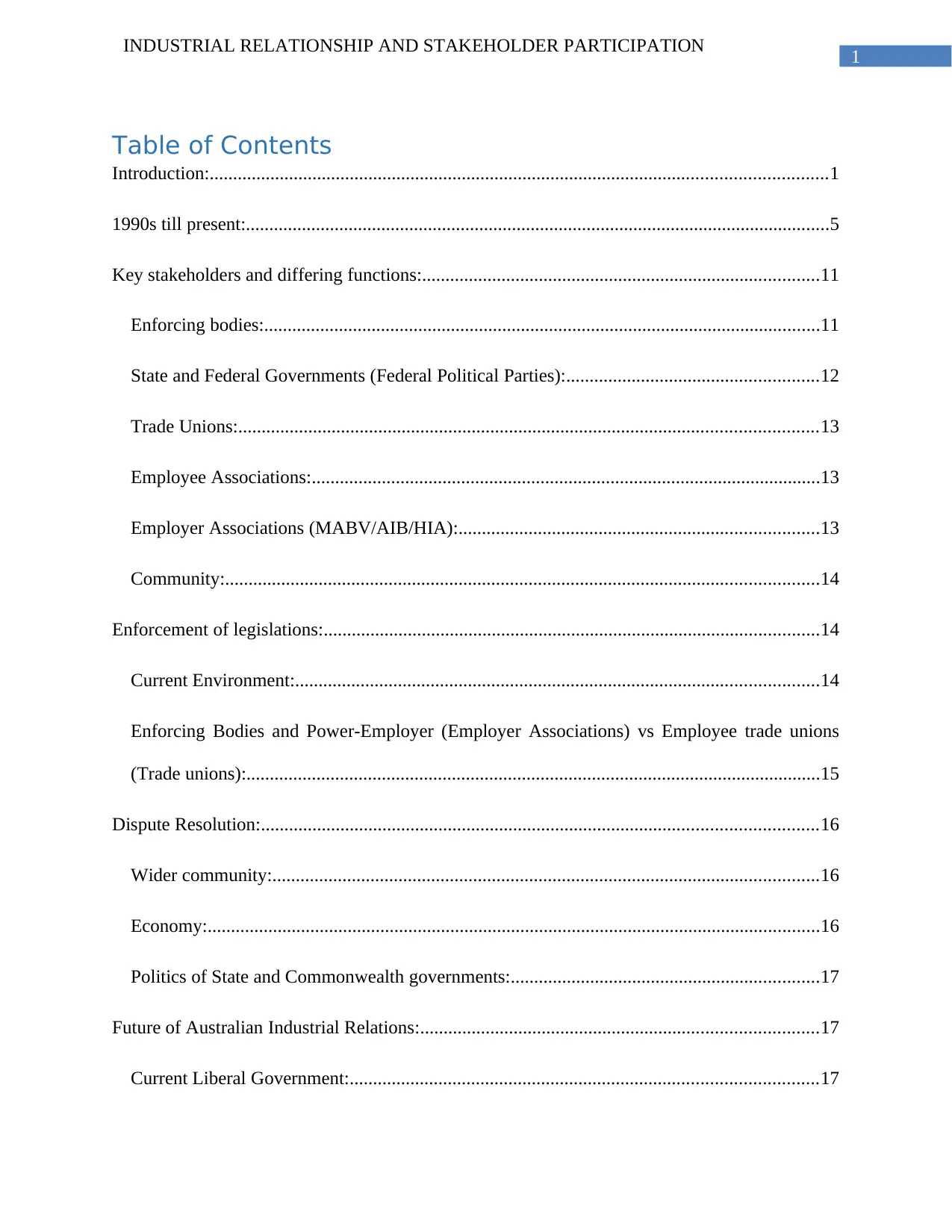
1
INDUSTRIAL RELATIONSHIP AND STAKEHOLDER PARTICIPATION
Table of Contents
Introduction:....................................................................................................................................1
1990s till present:.............................................................................................................................5
Key stakeholders and differing functions:.....................................................................................11
Enforcing bodies:.......................................................................................................................11
State and Federal Governments (Federal Political Parties):......................................................12
Trade Unions:............................................................................................................................13
Employee Associations:.............................................................................................................13
Employer Associations (MABV/AIB/HIA):.............................................................................13
Community:...............................................................................................................................14
Enforcement of legislations:..........................................................................................................14
Current Environment:................................................................................................................14
Enforcing Bodies and Power-Employer (Employer Associations) vs Employee trade unions
(Trade unions):...........................................................................................................................15
Dispute Resolution:.......................................................................................................................16
Wider community:.....................................................................................................................16
Economy:...................................................................................................................................16
Politics of State and Commonwealth governments:..................................................................17
Future of Australian Industrial Relations:.....................................................................................17
Current Liberal Government:....................................................................................................17
INDUSTRIAL RELATIONSHIP AND STAKEHOLDER PARTICIPATION
Table of Contents
Introduction:....................................................................................................................................1
1990s till present:.............................................................................................................................5
Key stakeholders and differing functions:.....................................................................................11
Enforcing bodies:.......................................................................................................................11
State and Federal Governments (Federal Political Parties):......................................................12
Trade Unions:............................................................................................................................13
Employee Associations:.............................................................................................................13
Employer Associations (MABV/AIB/HIA):.............................................................................13
Community:...............................................................................................................................14
Enforcement of legislations:..........................................................................................................14
Current Environment:................................................................................................................14
Enforcing Bodies and Power-Employer (Employer Associations) vs Employee trade unions
(Trade unions):...........................................................................................................................15
Dispute Resolution:.......................................................................................................................16
Wider community:.....................................................................................................................16
Economy:...................................................................................................................................16
Politics of State and Commonwealth governments:..................................................................17
Future of Australian Industrial Relations:.....................................................................................17
Current Liberal Government:....................................................................................................17
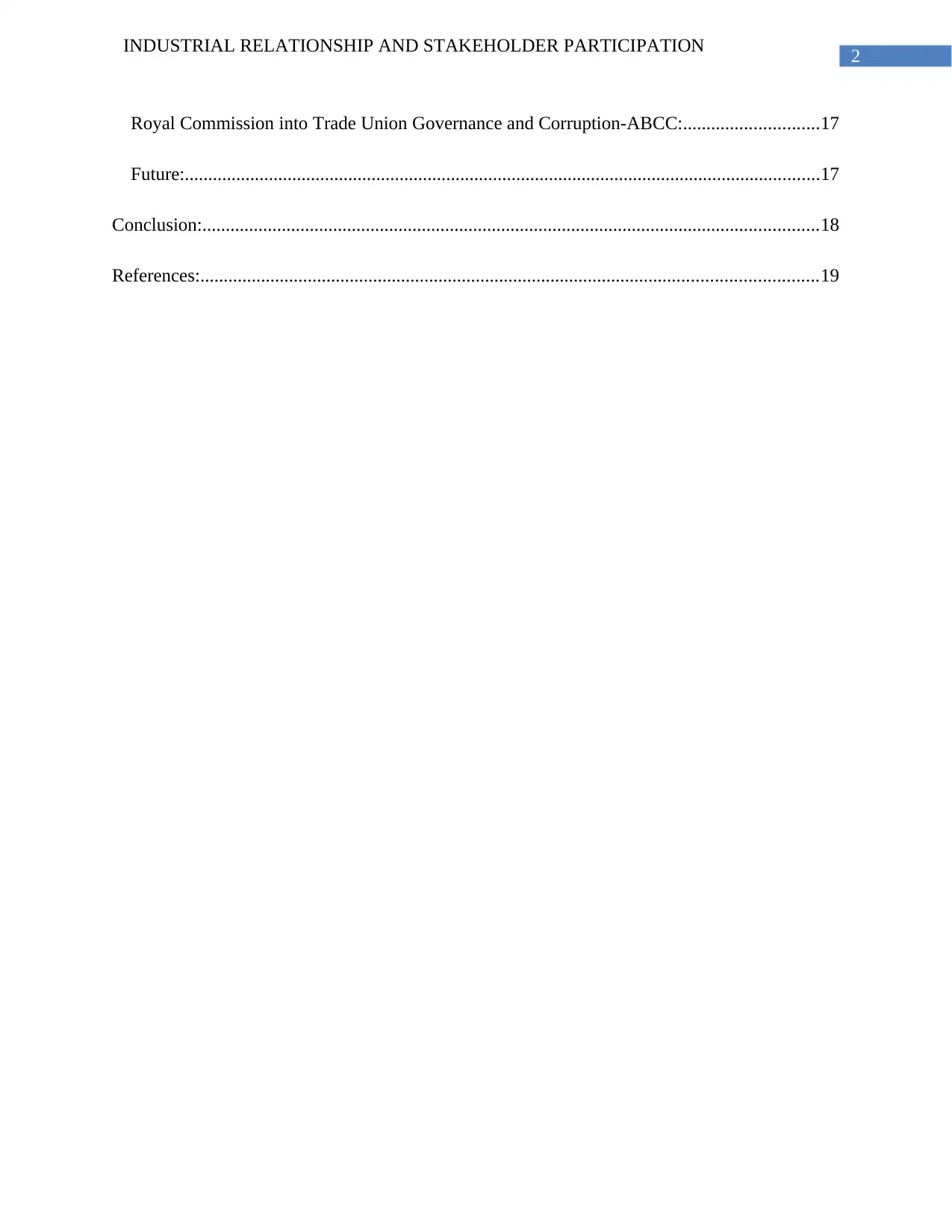
2
INDUSTRIAL RELATIONSHIP AND STAKEHOLDER PARTICIPATION
Royal Commission into Trade Union Governance and Corruption-ABCC:.............................17
Future:........................................................................................................................................17
Conclusion:....................................................................................................................................18
References:....................................................................................................................................19
INDUSTRIAL RELATIONSHIP AND STAKEHOLDER PARTICIPATION
Royal Commission into Trade Union Governance and Corruption-ABCC:.............................17
Future:........................................................................................................................................17
Conclusion:....................................................................................................................................18
References:....................................................................................................................................19
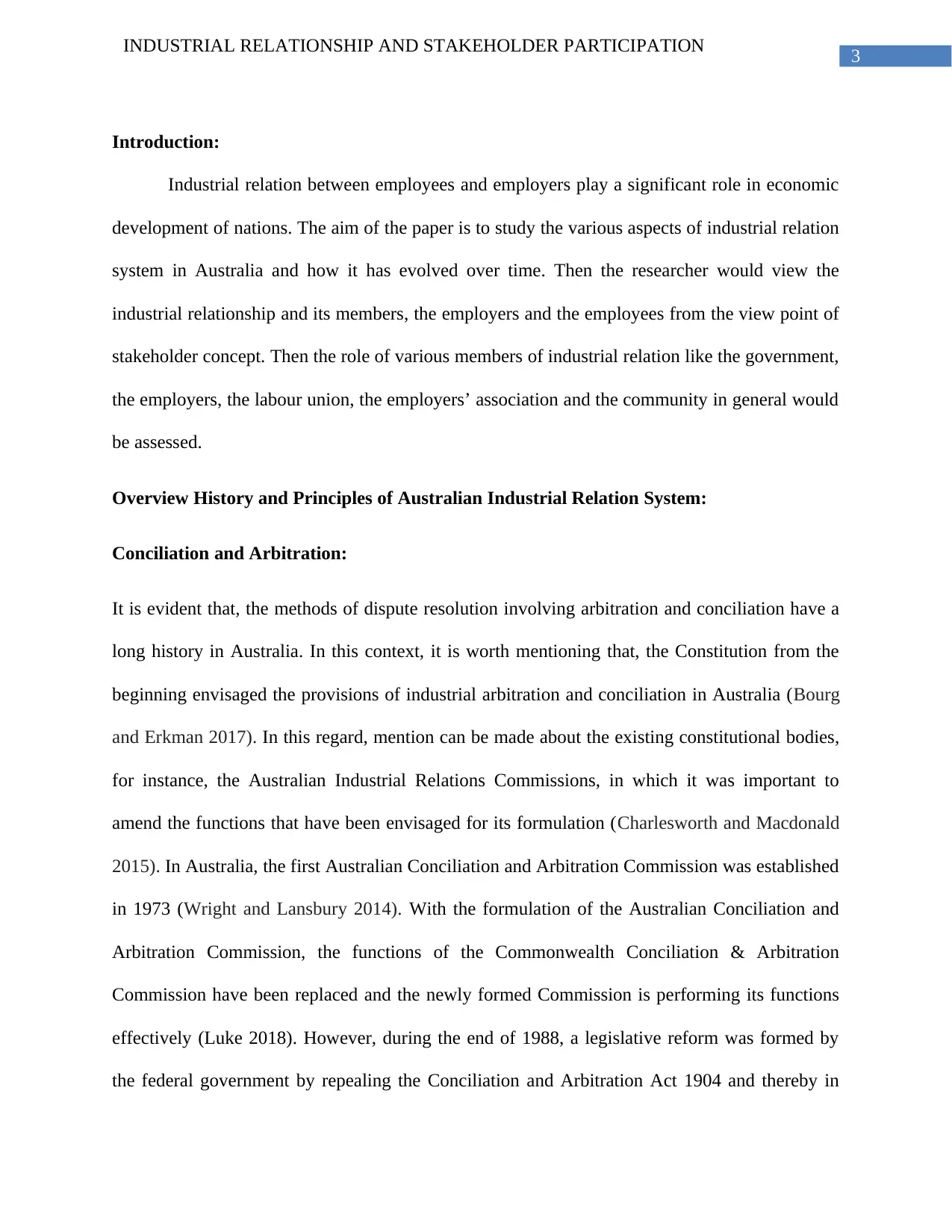
3
INDUSTRIAL RELATIONSHIP AND STAKEHOLDER PARTICIPATION
Introduction:
Industrial relation between employees and employers play a significant role in economic
development of nations. The aim of the paper is to study the various aspects of industrial relation
system in Australia and how it has evolved over time. Then the researcher would view the
industrial relationship and its members, the employers and the employees from the view point of
stakeholder concept. Then the role of various members of industrial relation like the government,
the employers, the labour union, the employers’ association and the community in general would
be assessed.
Overview History and Principles of Australian Industrial Relation System:
Conciliation and Arbitration:
It is evident that, the methods of dispute resolution involving arbitration and conciliation have a
long history in Australia. In this context, it is worth mentioning that, the Constitution from the
beginning envisaged the provisions of industrial arbitration and conciliation in Australia (Bourg
and Erkman 2017). In this regard, mention can be made about the existing constitutional bodies,
for instance, the Australian Industrial Relations Commissions, in which it was important to
amend the functions that have been envisaged for its formulation (Charlesworth and Macdonald
2015). In Australia, the first Australian Conciliation and Arbitration Commission was established
in 1973 (Wright and Lansbury 2014). With the formulation of the Australian Conciliation and
Arbitration Commission, the functions of the Commonwealth Conciliation & Arbitration
Commission have been replaced and the newly formed Commission is performing its functions
effectively (Luke 2018). However, during the end of 1988, a legislative reform was formed by
the federal government by repealing the Conciliation and Arbitration Act 1904 and thereby in
INDUSTRIAL RELATIONSHIP AND STAKEHOLDER PARTICIPATION
Introduction:
Industrial relation between employees and employers play a significant role in economic
development of nations. The aim of the paper is to study the various aspects of industrial relation
system in Australia and how it has evolved over time. Then the researcher would view the
industrial relationship and its members, the employers and the employees from the view point of
stakeholder concept. Then the role of various members of industrial relation like the government,
the employers, the labour union, the employers’ association and the community in general would
be assessed.
Overview History and Principles of Australian Industrial Relation System:
Conciliation and Arbitration:
It is evident that, the methods of dispute resolution involving arbitration and conciliation have a
long history in Australia. In this context, it is worth mentioning that, the Constitution from the
beginning envisaged the provisions of industrial arbitration and conciliation in Australia (Bourg
and Erkman 2017). In this regard, mention can be made about the existing constitutional bodies,
for instance, the Australian Industrial Relations Commissions, in which it was important to
amend the functions that have been envisaged for its formulation (Charlesworth and Macdonald
2015). In Australia, the first Australian Conciliation and Arbitration Commission was established
in 1973 (Wright and Lansbury 2014). With the formulation of the Australian Conciliation and
Arbitration Commission, the functions of the Commonwealth Conciliation & Arbitration
Commission have been replaced and the newly formed Commission is performing its functions
effectively (Luke 2018). However, during the end of 1988, a legislative reform was formed by
the federal government by repealing the Conciliation and Arbitration Act 1904 and thereby in
Secure Best Marks with AI Grader
Need help grading? Try our AI Grader for instant feedback on your assignments.
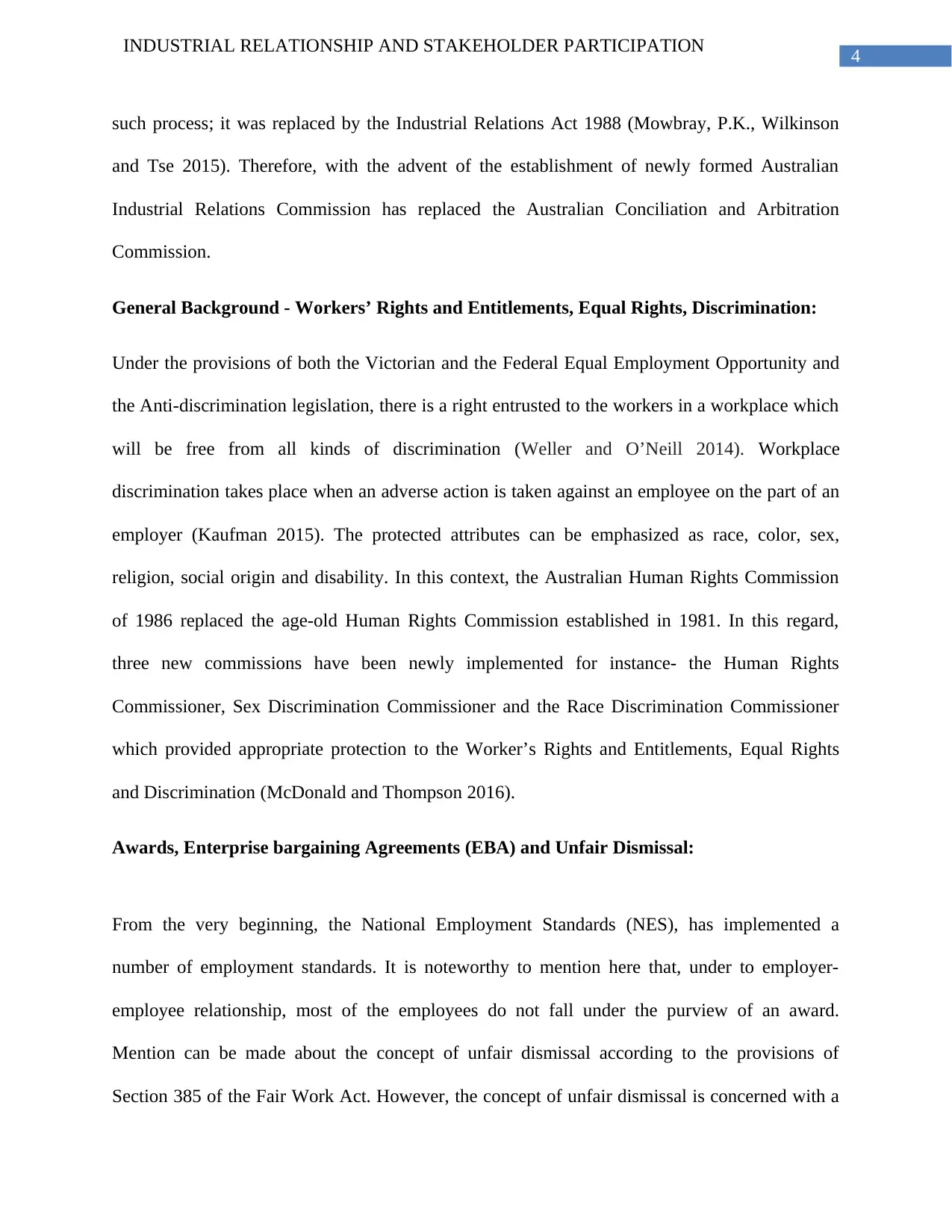
4
INDUSTRIAL RELATIONSHIP AND STAKEHOLDER PARTICIPATION
such process; it was replaced by the Industrial Relations Act 1988 (Mowbray, P.K., Wilkinson
and Tse 2015). Therefore, with the advent of the establishment of newly formed Australian
Industrial Relations Commission has replaced the Australian Conciliation and Arbitration
Commission.
General Background - Workers’ Rights and Entitlements, Equal Rights, Discrimination:
Under the provisions of both the Victorian and the Federal Equal Employment Opportunity and
the Anti-discrimination legislation, there is a right entrusted to the workers in a workplace which
will be free from all kinds of discrimination (Weller and O’Neill 2014). Workplace
discrimination takes place when an adverse action is taken against an employee on the part of an
employer (Kaufman 2015). The protected attributes can be emphasized as race, color, sex,
religion, social origin and disability. In this context, the Australian Human Rights Commission
of 1986 replaced the age-old Human Rights Commission established in 1981. In this regard,
three new commissions have been newly implemented for instance- the Human Rights
Commissioner, Sex Discrimination Commissioner and the Race Discrimination Commissioner
which provided appropriate protection to the Worker’s Rights and Entitlements, Equal Rights
and Discrimination (McDonald and Thompson 2016).
Awards, Enterprise bargaining Agreements (EBA) and Unfair Dismissal:
From the very beginning, the National Employment Standards (NES), has implemented a
number of employment standards. It is noteworthy to mention here that, under to employer-
employee relationship, most of the employees do not fall under the purview of an award.
Mention can be made about the concept of unfair dismissal according to the provisions of
Section 385 of the Fair Work Act. However, the concept of unfair dismissal is concerned with a
INDUSTRIAL RELATIONSHIP AND STAKEHOLDER PARTICIPATION
such process; it was replaced by the Industrial Relations Act 1988 (Mowbray, P.K., Wilkinson
and Tse 2015). Therefore, with the advent of the establishment of newly formed Australian
Industrial Relations Commission has replaced the Australian Conciliation and Arbitration
Commission.
General Background - Workers’ Rights and Entitlements, Equal Rights, Discrimination:
Under the provisions of both the Victorian and the Federal Equal Employment Opportunity and
the Anti-discrimination legislation, there is a right entrusted to the workers in a workplace which
will be free from all kinds of discrimination (Weller and O’Neill 2014). Workplace
discrimination takes place when an adverse action is taken against an employee on the part of an
employer (Kaufman 2015). The protected attributes can be emphasized as race, color, sex,
religion, social origin and disability. In this context, the Australian Human Rights Commission
of 1986 replaced the age-old Human Rights Commission established in 1981. In this regard,
three new commissions have been newly implemented for instance- the Human Rights
Commissioner, Sex Discrimination Commissioner and the Race Discrimination Commissioner
which provided appropriate protection to the Worker’s Rights and Entitlements, Equal Rights
and Discrimination (McDonald and Thompson 2016).
Awards, Enterprise bargaining Agreements (EBA) and Unfair Dismissal:
From the very beginning, the National Employment Standards (NES), has implemented a
number of employment standards. It is noteworthy to mention here that, under to employer-
employee relationship, most of the employees do not fall under the purview of an award.
Mention can be made about the concept of unfair dismissal according to the provisions of
Section 385 of the Fair Work Act. However, the concept of unfair dismissal is concerned with a
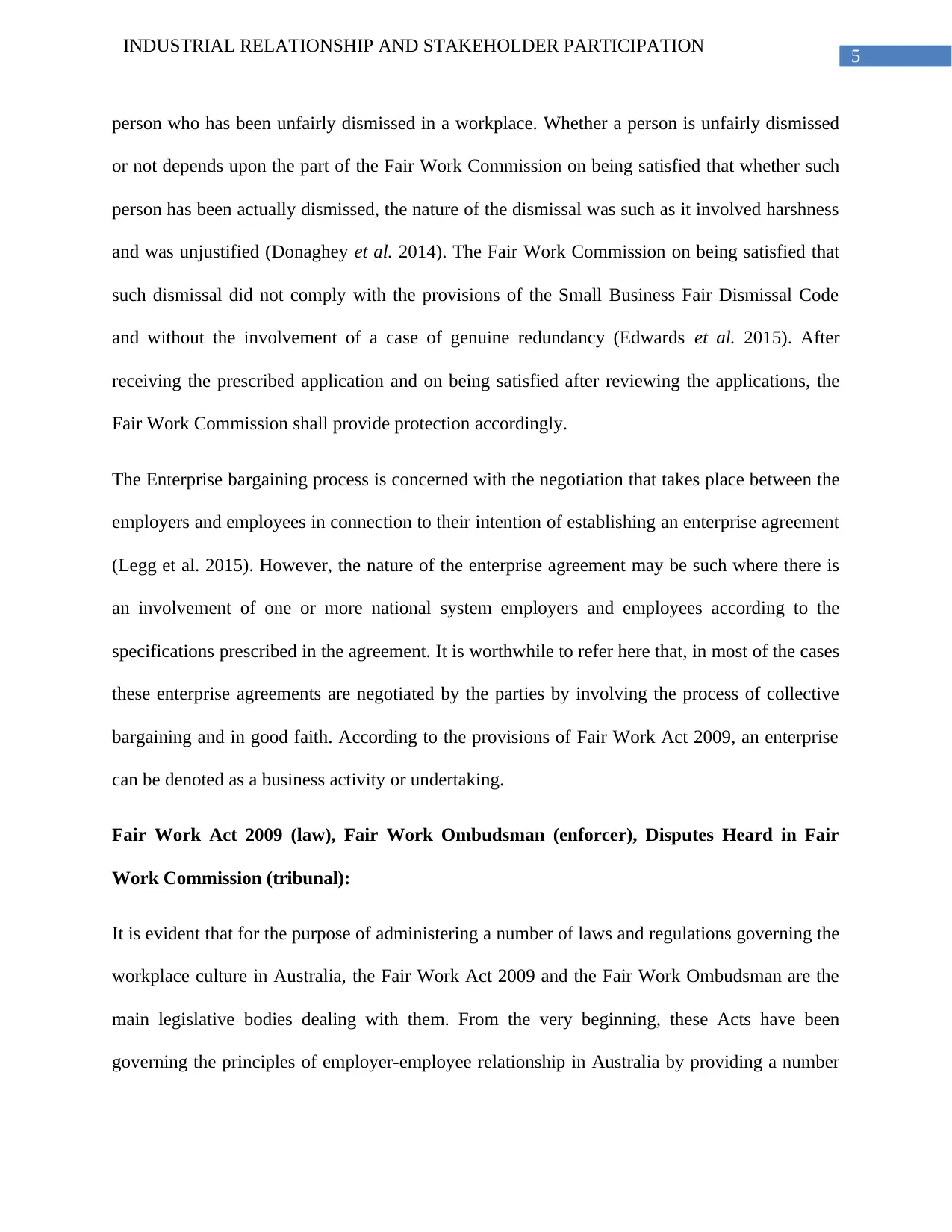
5
INDUSTRIAL RELATIONSHIP AND STAKEHOLDER PARTICIPATION
person who has been unfairly dismissed in a workplace. Whether a person is unfairly dismissed
or not depends upon the part of the Fair Work Commission on being satisfied that whether such
person has been actually dismissed, the nature of the dismissal was such as it involved harshness
and was unjustified (Donaghey et al. 2014). The Fair Work Commission on being satisfied that
such dismissal did not comply with the provisions of the Small Business Fair Dismissal Code
and without the involvement of a case of genuine redundancy (Edwards et al. 2015). After
receiving the prescribed application and on being satisfied after reviewing the applications, the
Fair Work Commission shall provide protection accordingly.
The Enterprise bargaining process is concerned with the negotiation that takes place between the
employers and employees in connection to their intention of establishing an enterprise agreement
(Legg et al. 2015). However, the nature of the enterprise agreement may be such where there is
an involvement of one or more national system employers and employees according to the
specifications prescribed in the agreement. It is worthwhile to refer here that, in most of the cases
these enterprise agreements are negotiated by the parties by involving the process of collective
bargaining and in good faith. According to the provisions of Fair Work Act 2009, an enterprise
can be denoted as a business activity or undertaking.
Fair Work Act 2009 (law), Fair Work Ombudsman (enforcer), Disputes Heard in Fair
Work Commission (tribunal):
It is evident that for the purpose of administering a number of laws and regulations governing the
workplace culture in Australia, the Fair Work Act 2009 and the Fair Work Ombudsman are the
main legislative bodies dealing with them. From the very beginning, these Acts have been
governing the principles of employer-employee relationship in Australia by providing a number
INDUSTRIAL RELATIONSHIP AND STAKEHOLDER PARTICIPATION
person who has been unfairly dismissed in a workplace. Whether a person is unfairly dismissed
or not depends upon the part of the Fair Work Commission on being satisfied that whether such
person has been actually dismissed, the nature of the dismissal was such as it involved harshness
and was unjustified (Donaghey et al. 2014). The Fair Work Commission on being satisfied that
such dismissal did not comply with the provisions of the Small Business Fair Dismissal Code
and without the involvement of a case of genuine redundancy (Edwards et al. 2015). After
receiving the prescribed application and on being satisfied after reviewing the applications, the
Fair Work Commission shall provide protection accordingly.
The Enterprise bargaining process is concerned with the negotiation that takes place between the
employers and employees in connection to their intention of establishing an enterprise agreement
(Legg et al. 2015). However, the nature of the enterprise agreement may be such where there is
an involvement of one or more national system employers and employees according to the
specifications prescribed in the agreement. It is worthwhile to refer here that, in most of the cases
these enterprise agreements are negotiated by the parties by involving the process of collective
bargaining and in good faith. According to the provisions of Fair Work Act 2009, an enterprise
can be denoted as a business activity or undertaking.
Fair Work Act 2009 (law), Fair Work Ombudsman (enforcer), Disputes Heard in Fair
Work Commission (tribunal):
It is evident that for the purpose of administering a number of laws and regulations governing the
workplace culture in Australia, the Fair Work Act 2009 and the Fair Work Ombudsman are the
main legislative bodies dealing with them. From the very beginning, these Acts have been
governing the principles of employer-employee relationship in Australia by providing a number

6
INDUSTRIAL RELATIONSHIP AND STAKEHOLDER PARTICIPATION
of safety measures and working standards for the purpose of maintaining fairness in work by
preventing workplace discrimination to the large extent.
Building and Construction Industry (Improving Productivity) Act 2016 (law), Australian
Building and Construction Commission (ABBC) is Enforcer, Disputes Heard in Fair Work
Commission (tribunal):
The activities of industrial actions are primarily regulated under the provisions of the Fair Work
Act 2009. In this regard, it is worth noting that, the industrial actions in relation to the building
work is subjected to various additional rules as depicted in the Building and Construction
Industry (Improving Productivity) Act 2016 (BCIIP Act). The Building and Construction
Industry from time to time takes into consideration various industrial actions however; the
industrial actions that are not protected are considered to be unlawful (Donaghey et al. 2014). It
is noteworthy to mention here that, industrial actions can be protected if there involves
negotiation of new agreements and that the expiration of the existing agreement has passed
away. In case of action on the part of the employees, the Building and Construction Industry
(Improving Productivity) Act 2016 (BCIIP Act) shall protect industrial action if the concerned
protection action order has already received authorization on the part of a secret ballot of the
concerned employees. However, such approach is possible only if, there is an attempt on the part
of the bargaining representatives to reach the actual agreement (Mowbray, P.K., Wilkinson and
Tse 2015). The Building and Construction Industry (Improving Productivity) Act 2016 (BCIIP
Act) shall be able to provide appropriate solution only if the prescribed notices and the orders of
the Fair Work Commission have been complied with (Charlesworth and Macdonald 2015).
Federal system of Australia:
INDUSTRIAL RELATIONSHIP AND STAKEHOLDER PARTICIPATION
of safety measures and working standards for the purpose of maintaining fairness in work by
preventing workplace discrimination to the large extent.
Building and Construction Industry (Improving Productivity) Act 2016 (law), Australian
Building and Construction Commission (ABBC) is Enforcer, Disputes Heard in Fair Work
Commission (tribunal):
The activities of industrial actions are primarily regulated under the provisions of the Fair Work
Act 2009. In this regard, it is worth noting that, the industrial actions in relation to the building
work is subjected to various additional rules as depicted in the Building and Construction
Industry (Improving Productivity) Act 2016 (BCIIP Act). The Building and Construction
Industry from time to time takes into consideration various industrial actions however; the
industrial actions that are not protected are considered to be unlawful (Donaghey et al. 2014). It
is noteworthy to mention here that, industrial actions can be protected if there involves
negotiation of new agreements and that the expiration of the existing agreement has passed
away. In case of action on the part of the employees, the Building and Construction Industry
(Improving Productivity) Act 2016 (BCIIP Act) shall protect industrial action if the concerned
protection action order has already received authorization on the part of a secret ballot of the
concerned employees. However, such approach is possible only if, there is an attempt on the part
of the bargaining representatives to reach the actual agreement (Mowbray, P.K., Wilkinson and
Tse 2015). The Building and Construction Industry (Improving Productivity) Act 2016 (BCIIP
Act) shall be able to provide appropriate solution only if the prescribed notices and the orders of
the Fair Work Commission have been complied with (Charlesworth and Macdonald 2015).
Federal system of Australia:
Paraphrase This Document
Need a fresh take? Get an instant paraphrase of this document with our AI Paraphraser
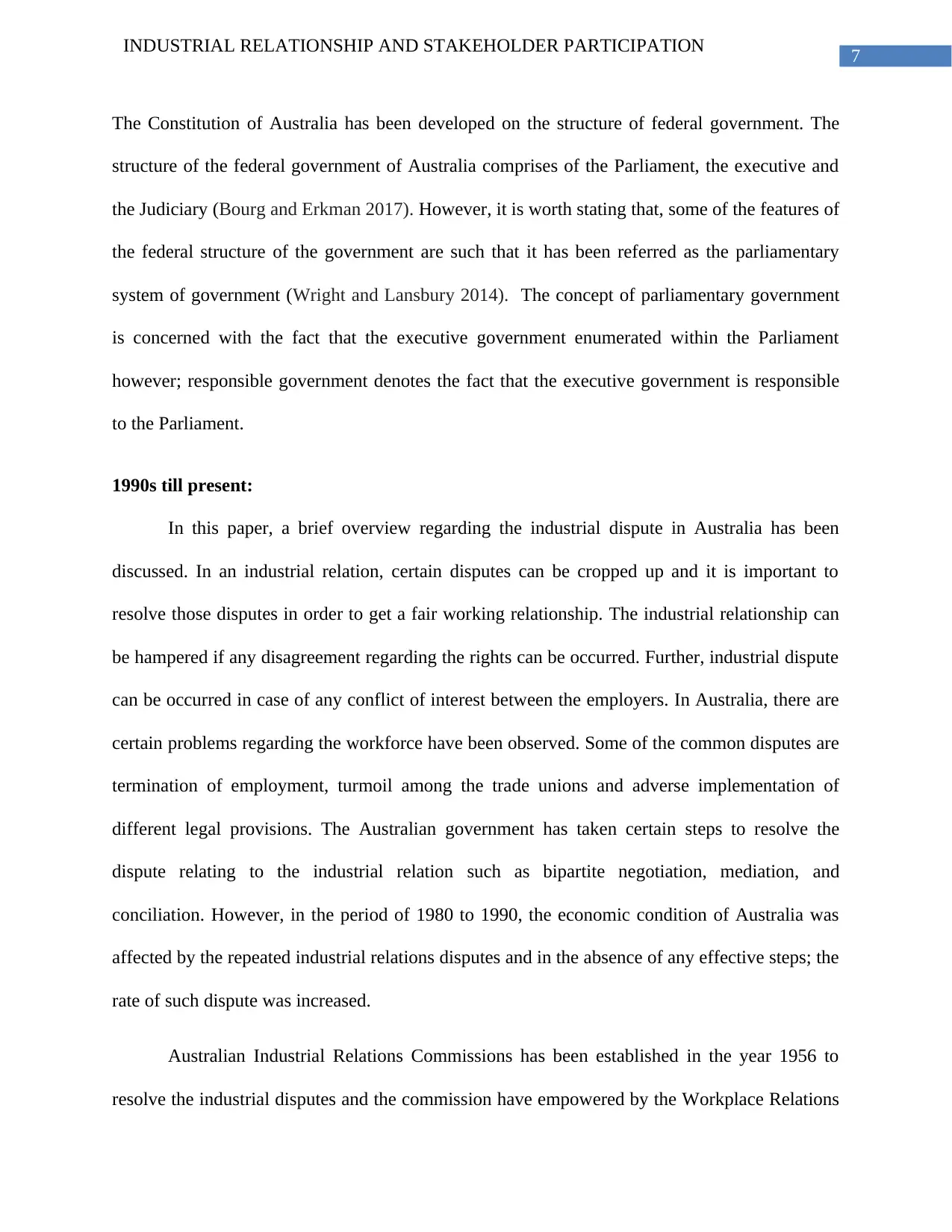
7
INDUSTRIAL RELATIONSHIP AND STAKEHOLDER PARTICIPATION
The Constitution of Australia has been developed on the structure of federal government. The
structure of the federal government of Australia comprises of the Parliament, the executive and
the Judiciary (Bourg and Erkman 2017). However, it is worth stating that, some of the features of
the federal structure of the government are such that it has been referred as the parliamentary
system of government (Wright and Lansbury 2014). The concept of parliamentary government
is concerned with the fact that the executive government enumerated within the Parliament
however; responsible government denotes the fact that the executive government is responsible
to the Parliament.
1990s till present:
In this paper, a brief overview regarding the industrial dispute in Australia has been
discussed. In an industrial relation, certain disputes can be cropped up and it is important to
resolve those disputes in order to get a fair working relationship. The industrial relationship can
be hampered if any disagreement regarding the rights can be occurred. Further, industrial dispute
can be occurred in case of any conflict of interest between the employers. In Australia, there are
certain problems regarding the workforce have been observed. Some of the common disputes are
termination of employment, turmoil among the trade unions and adverse implementation of
different legal provisions. The Australian government has taken certain steps to resolve the
dispute relating to the industrial relation such as bipartite negotiation, mediation, and
conciliation. However, in the period of 1980 to 1990, the economic condition of Australia was
affected by the repeated industrial relations disputes and in the absence of any effective steps; the
rate of such dispute was increased.
Australian Industrial Relations Commissions has been established in the year 1956 to
resolve the industrial disputes and the commission have empowered by the Workplace Relations
INDUSTRIAL RELATIONSHIP AND STAKEHOLDER PARTICIPATION
The Constitution of Australia has been developed on the structure of federal government. The
structure of the federal government of Australia comprises of the Parliament, the executive and
the Judiciary (Bourg and Erkman 2017). However, it is worth stating that, some of the features of
the federal structure of the government are such that it has been referred as the parliamentary
system of government (Wright and Lansbury 2014). The concept of parliamentary government
is concerned with the fact that the executive government enumerated within the Parliament
however; responsible government denotes the fact that the executive government is responsible
to the Parliament.
1990s till present:
In this paper, a brief overview regarding the industrial dispute in Australia has been
discussed. In an industrial relation, certain disputes can be cropped up and it is important to
resolve those disputes in order to get a fair working relationship. The industrial relationship can
be hampered if any disagreement regarding the rights can be occurred. Further, industrial dispute
can be occurred in case of any conflict of interest between the employers. In Australia, there are
certain problems regarding the workforce have been observed. Some of the common disputes are
termination of employment, turmoil among the trade unions and adverse implementation of
different legal provisions. The Australian government has taken certain steps to resolve the
dispute relating to the industrial relation such as bipartite negotiation, mediation, and
conciliation. However, in the period of 1980 to 1990, the economic condition of Australia was
affected by the repeated industrial relations disputes and in the absence of any effective steps; the
rate of such dispute was increased.
Australian Industrial Relations Commissions has been established in the year 1956 to
resolve the industrial disputes and the commission have empowered by the Workplace Relations

8
INDUSTRIAL RELATIONSHIP AND STAKEHOLDER PARTICIPATION
Act 1996. This institution has played an important role during 1980 to 1990, when the problem
regarding industrial matters was at hike. This institution was regarded as one of the most suitable
institution for the labour dispute. This institution has promoted the process of negotiation. The
existence of the Commonwealth Court of Conciliation Court has been ceased by an order of the
High Court of Australia where the court has been observed that the conciliation courts can enjoy
certain power of the court but the nature of court is tribunal and it should not exercise judicial
power in any case. However, after that period, the following commission has been introduced
and it provides awards on equal work and equal pay. Further, all the enterprise bargaining
agreements were guided by this commission. The main objective of the commission was to
maintain a fair working environment in the industrial relationship.
There are certain terms that have been used under the industrial disputes. The term enterprise
bargaining is a process where certain discussion has been made between the employers and
employees in respect of the wage and working condition. The term bargaining denotes
negotiation. In this process, negotiation regarding the waging and working condition has been
done and once the same has been decided, the order become mandatorily applicable on the
parties. However, there are two agreements in the process such as collective agreement and
collaborative agreement. Fair Work Act 2009 has done the negotiation process.
It has been observed that during the time of the industrial dispute, certain legal provision have
been reformed and certain workplace agreements have been made in between the industrial
parties. The term workplace agreement exists when certain negotiation process developed in
between the employers and the employees. The provision of the workplace agreements are based
on the provisions of the Workplace Relations Act 1996. The main purpose of the agreement is to
INDUSTRIAL RELATIONSHIP AND STAKEHOLDER PARTICIPATION
Act 1996. This institution has played an important role during 1980 to 1990, when the problem
regarding industrial matters was at hike. This institution was regarded as one of the most suitable
institution for the labour dispute. This institution has promoted the process of negotiation. The
existence of the Commonwealth Court of Conciliation Court has been ceased by an order of the
High Court of Australia where the court has been observed that the conciliation courts can enjoy
certain power of the court but the nature of court is tribunal and it should not exercise judicial
power in any case. However, after that period, the following commission has been introduced
and it provides awards on equal work and equal pay. Further, all the enterprise bargaining
agreements were guided by this commission. The main objective of the commission was to
maintain a fair working environment in the industrial relationship.
There are certain terms that have been used under the industrial disputes. The term enterprise
bargaining is a process where certain discussion has been made between the employers and
employees in respect of the wage and working condition. The term bargaining denotes
negotiation. In this process, negotiation regarding the waging and working condition has been
done and once the same has been decided, the order become mandatorily applicable on the
parties. However, there are two agreements in the process such as collective agreement and
collaborative agreement. Fair Work Act 2009 has done the negotiation process.
It has been observed that during the time of the industrial dispute, certain legal provision have
been reformed and certain workplace agreements have been made in between the industrial
parties. The term workplace agreement exists when certain negotiation process developed in
between the employers and the employees. The provision of the workplace agreements are based
on the provisions of the Workplace Relations Act 1996. The main purpose of the agreement is to
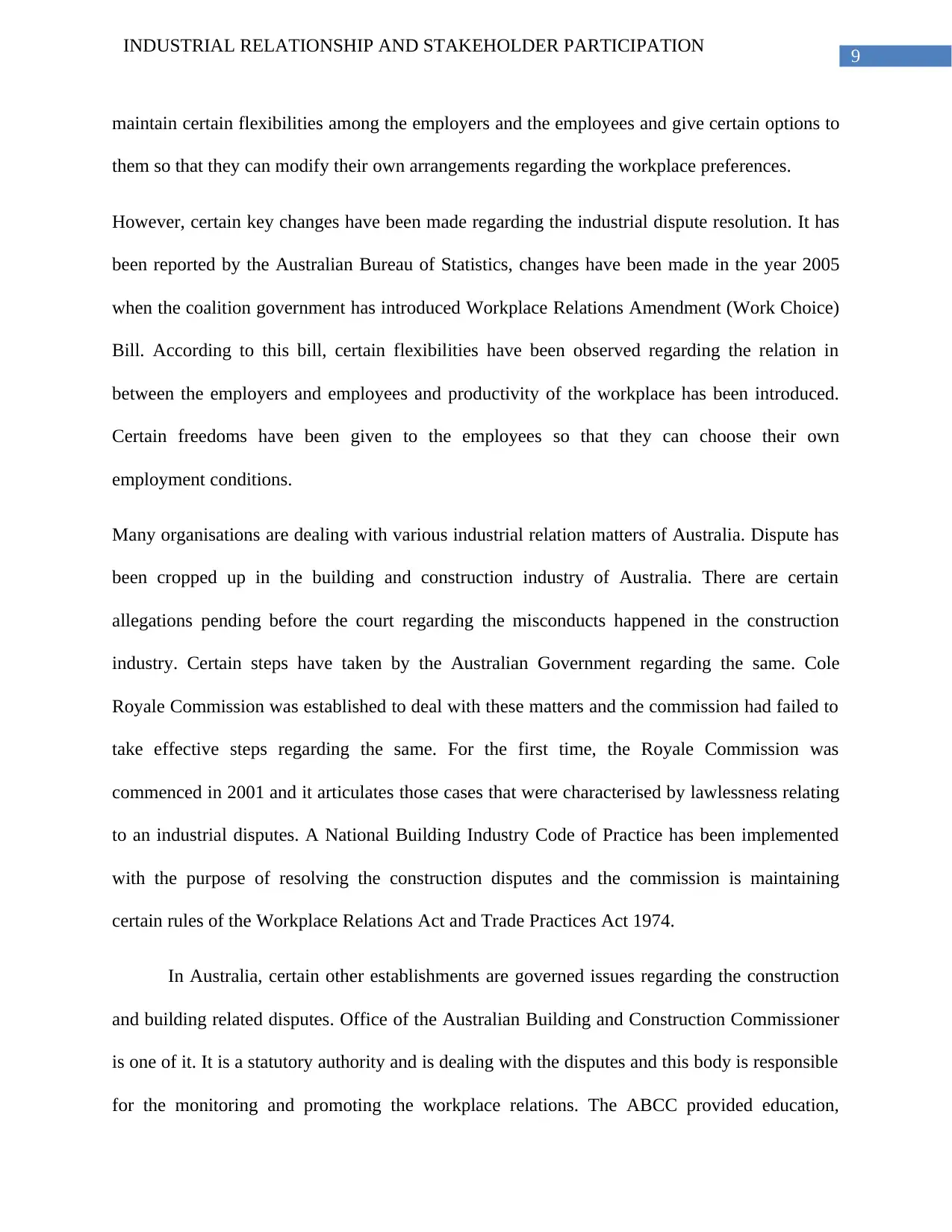
9
INDUSTRIAL RELATIONSHIP AND STAKEHOLDER PARTICIPATION
maintain certain flexibilities among the employers and the employees and give certain options to
them so that they can modify their own arrangements regarding the workplace preferences.
However, certain key changes have been made regarding the industrial dispute resolution. It has
been reported by the Australian Bureau of Statistics, changes have been made in the year 2005
when the coalition government has introduced Workplace Relations Amendment (Work Choice)
Bill. According to this bill, certain flexibilities have been observed regarding the relation in
between the employers and employees and productivity of the workplace has been introduced.
Certain freedoms have been given to the employees so that they can choose their own
employment conditions.
Many organisations are dealing with various industrial relation matters of Australia. Dispute has
been cropped up in the building and construction industry of Australia. There are certain
allegations pending before the court regarding the misconducts happened in the construction
industry. Certain steps have taken by the Australian Government regarding the same. Cole
Royale Commission was established to deal with these matters and the commission had failed to
take effective steps regarding the same. For the first time, the Royale Commission was
commenced in 2001 and it articulates those cases that were characterised by lawlessness relating
to an industrial disputes. A National Building Industry Code of Practice has been implemented
with the purpose of resolving the construction disputes and the commission is maintaining
certain rules of the Workplace Relations Act and Trade Practices Act 1974.
In Australia, certain other establishments are governed issues regarding the construction
and building related disputes. Office of the Australian Building and Construction Commissioner
is one of it. It is a statutory authority and is dealing with the disputes and this body is responsible
for the monitoring and promoting the workplace relations. The ABCC provided education,
INDUSTRIAL RELATIONSHIP AND STAKEHOLDER PARTICIPATION
maintain certain flexibilities among the employers and the employees and give certain options to
them so that they can modify their own arrangements regarding the workplace preferences.
However, certain key changes have been made regarding the industrial dispute resolution. It has
been reported by the Australian Bureau of Statistics, changes have been made in the year 2005
when the coalition government has introduced Workplace Relations Amendment (Work Choice)
Bill. According to this bill, certain flexibilities have been observed regarding the relation in
between the employers and employees and productivity of the workplace has been introduced.
Certain freedoms have been given to the employees so that they can choose their own
employment conditions.
Many organisations are dealing with various industrial relation matters of Australia. Dispute has
been cropped up in the building and construction industry of Australia. There are certain
allegations pending before the court regarding the misconducts happened in the construction
industry. Certain steps have taken by the Australian Government regarding the same. Cole
Royale Commission was established to deal with these matters and the commission had failed to
take effective steps regarding the same. For the first time, the Royale Commission was
commenced in 2001 and it articulates those cases that were characterised by lawlessness relating
to an industrial disputes. A National Building Industry Code of Practice has been implemented
with the purpose of resolving the construction disputes and the commission is maintaining
certain rules of the Workplace Relations Act and Trade Practices Act 1974.
In Australia, certain other establishments are governed issues regarding the construction
and building related disputes. Office of the Australian Building and Construction Commissioner
is one of it. It is a statutory authority and is dealing with the disputes and this body is responsible
for the monitoring and promoting the workplace relations. The ABCC provided education,
Secure Best Marks with AI Grader
Need help grading? Try our AI Grader for instant feedback on your assignments.
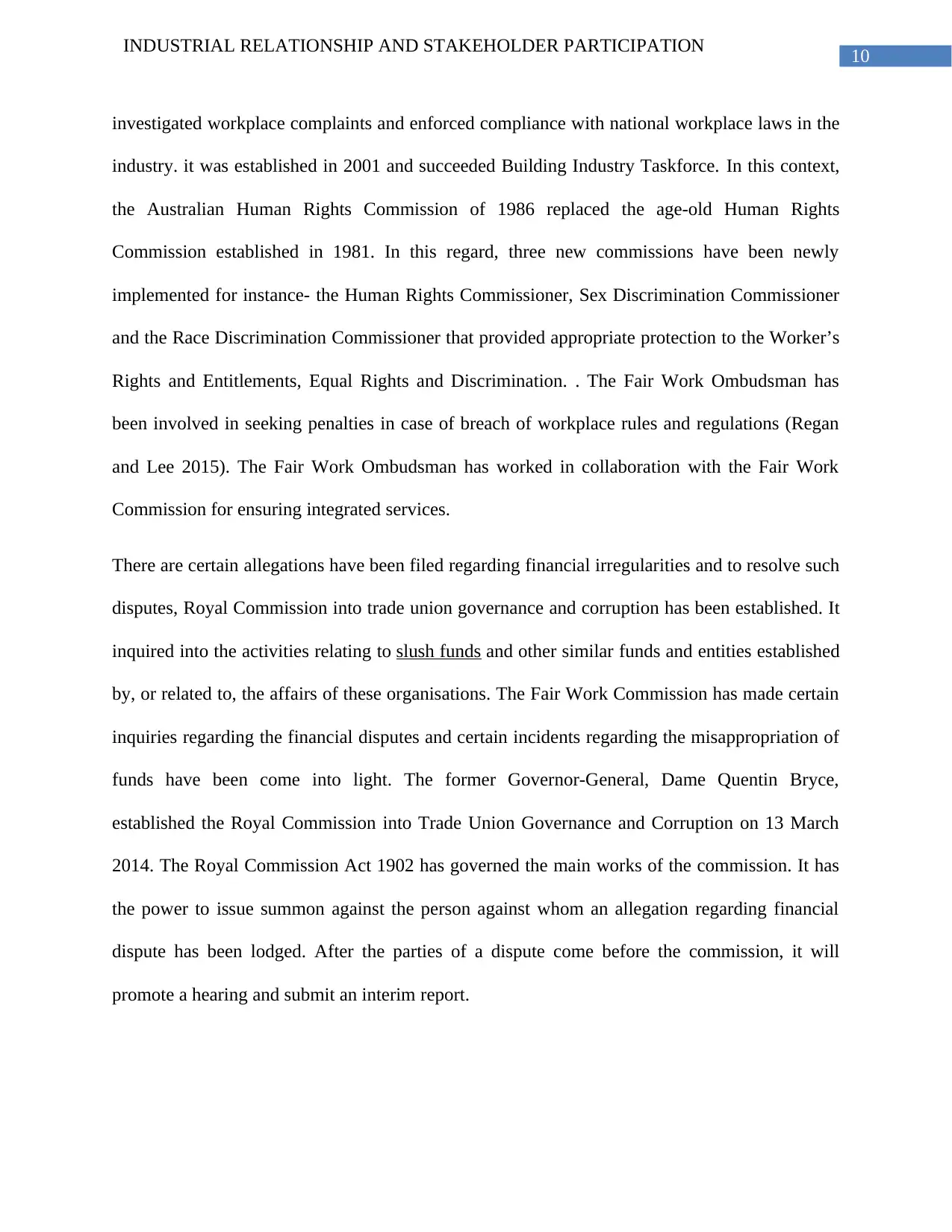
10
INDUSTRIAL RELATIONSHIP AND STAKEHOLDER PARTICIPATION
investigated workplace complaints and enforced compliance with national workplace laws in the
industry. it was established in 2001 and succeeded Building Industry Taskforce. In this context,
the Australian Human Rights Commission of 1986 replaced the age-old Human Rights
Commission established in 1981. In this regard, three new commissions have been newly
implemented for instance- the Human Rights Commissioner, Sex Discrimination Commissioner
and the Race Discrimination Commissioner that provided appropriate protection to the Worker’s
Rights and Entitlements, Equal Rights and Discrimination. . The Fair Work Ombudsman has
been involved in seeking penalties in case of breach of workplace rules and regulations (Regan
and Lee 2015). The Fair Work Ombudsman has worked in collaboration with the Fair Work
Commission for ensuring integrated services.
There are certain allegations have been filed regarding financial irregularities and to resolve such
disputes, Royal Commission into trade union governance and corruption has been established. It
inquired into the activities relating to slush funds and other similar funds and entities established
by, or related to, the affairs of these organisations. The Fair Work Commission has made certain
inquiries regarding the financial disputes and certain incidents regarding the misappropriation of
funds have been come into light. The former Governor-General, Dame Quentin Bryce,
established the Royal Commission into Trade Union Governance and Corruption on 13 March
2014. The Royal Commission Act 1902 has governed the main works of the commission. It has
the power to issue summon against the person against whom an allegation regarding financial
dispute has been lodged. After the parties of a dispute come before the commission, it will
promote a hearing and submit an interim report.
INDUSTRIAL RELATIONSHIP AND STAKEHOLDER PARTICIPATION
investigated workplace complaints and enforced compliance with national workplace laws in the
industry. it was established in 2001 and succeeded Building Industry Taskforce. In this context,
the Australian Human Rights Commission of 1986 replaced the age-old Human Rights
Commission established in 1981. In this regard, three new commissions have been newly
implemented for instance- the Human Rights Commissioner, Sex Discrimination Commissioner
and the Race Discrimination Commissioner that provided appropriate protection to the Worker’s
Rights and Entitlements, Equal Rights and Discrimination. . The Fair Work Ombudsman has
been involved in seeking penalties in case of breach of workplace rules and regulations (Regan
and Lee 2015). The Fair Work Ombudsman has worked in collaboration with the Fair Work
Commission for ensuring integrated services.
There are certain allegations have been filed regarding financial irregularities and to resolve such
disputes, Royal Commission into trade union governance and corruption has been established. It
inquired into the activities relating to slush funds and other similar funds and entities established
by, or related to, the affairs of these organisations. The Fair Work Commission has made certain
inquiries regarding the financial disputes and certain incidents regarding the misappropriation of
funds have been come into light. The former Governor-General, Dame Quentin Bryce,
established the Royal Commission into Trade Union Governance and Corruption on 13 March
2014. The Royal Commission Act 1902 has governed the main works of the commission. It has
the power to issue summon against the person against whom an allegation regarding financial
dispute has been lodged. After the parties of a dispute come before the commission, it will
promote a hearing and submit an interim report.
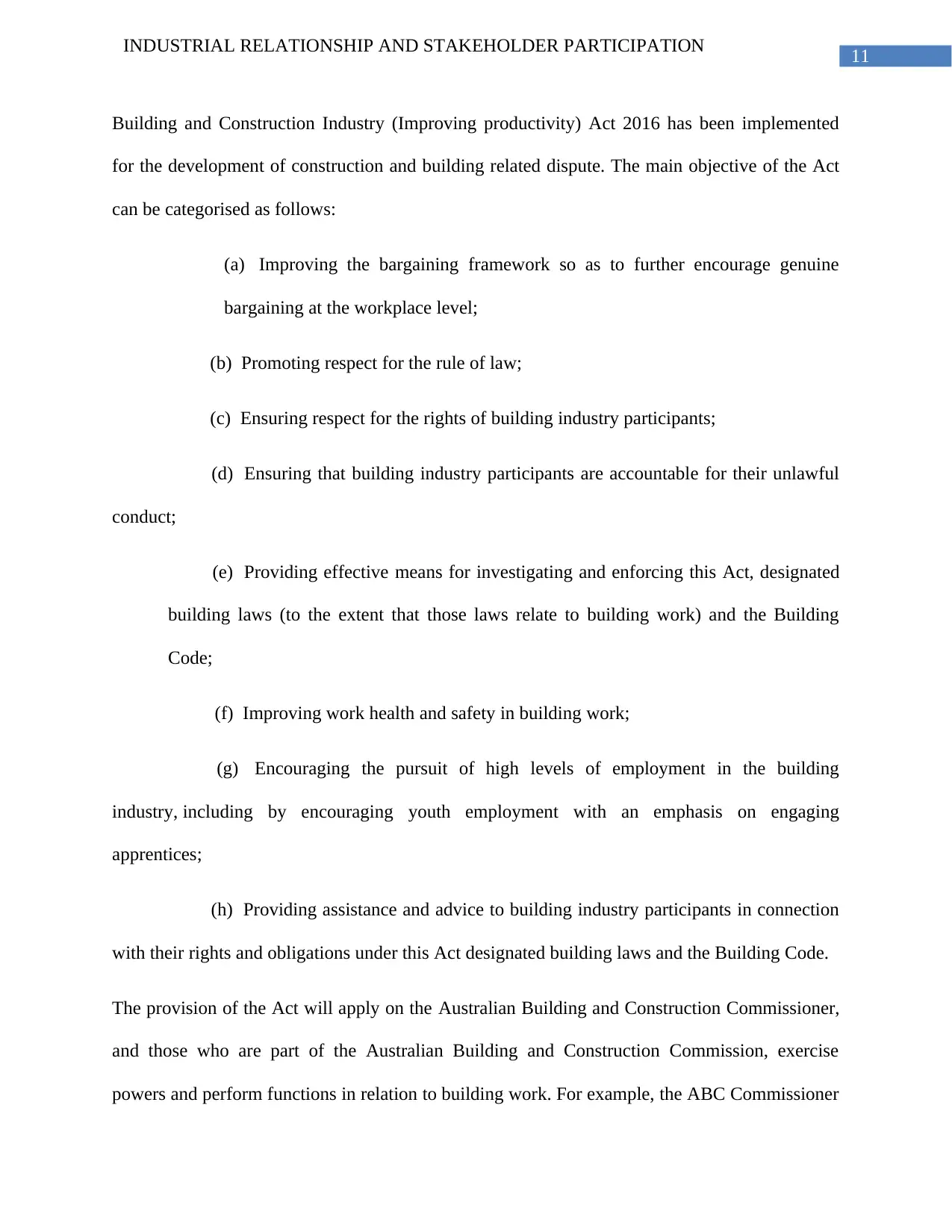
11
INDUSTRIAL RELATIONSHIP AND STAKEHOLDER PARTICIPATION
Building and Construction Industry (Improving productivity) Act 2016 has been implemented
for the development of construction and building related dispute. The main objective of the Act
can be categorised as follows:
(a) Improving the bargaining framework so as to further encourage genuine
bargaining at the workplace level;
(b) Promoting respect for the rule of law;
(c) Ensuring respect for the rights of building industry participants;
(d) Ensuring that building industry participants are accountable for their unlawful
conduct;
(e) Providing effective means for investigating and enforcing this Act, designated
building laws (to the extent that those laws relate to building work) and the Building
Code;
(f) Improving work health and safety in building work;
(g) Encouraging the pursuit of high levels of employment in the building
industry, including by encouraging youth employment with an emphasis on engaging
apprentices;
(h) Providing assistance and advice to building industry participants in connection
with their rights and obligations under this Act designated building laws and the Building Code.
The provision of the Act will apply on the Australian Building and Construction Commissioner,
and those who are part of the Australian Building and Construction Commission, exercise
powers and perform functions in relation to building work. For example, the ABC Commissioner
INDUSTRIAL RELATIONSHIP AND STAKEHOLDER PARTICIPATION
Building and Construction Industry (Improving productivity) Act 2016 has been implemented
for the development of construction and building related dispute. The main objective of the Act
can be categorised as follows:
(a) Improving the bargaining framework so as to further encourage genuine
bargaining at the workplace level;
(b) Promoting respect for the rule of law;
(c) Ensuring respect for the rights of building industry participants;
(d) Ensuring that building industry participants are accountable for their unlawful
conduct;
(e) Providing effective means for investigating and enforcing this Act, designated
building laws (to the extent that those laws relate to building work) and the Building
Code;
(f) Improving work health and safety in building work;
(g) Encouraging the pursuit of high levels of employment in the building
industry, including by encouraging youth employment with an emphasis on engaging
apprentices;
(h) Providing assistance and advice to building industry participants in connection
with their rights and obligations under this Act designated building laws and the Building Code.
The provision of the Act will apply on the Australian Building and Construction Commissioner,
and those who are part of the Australian Building and Construction Commission, exercise
powers and perform functions in relation to building work. For example, the ABC Commissioner
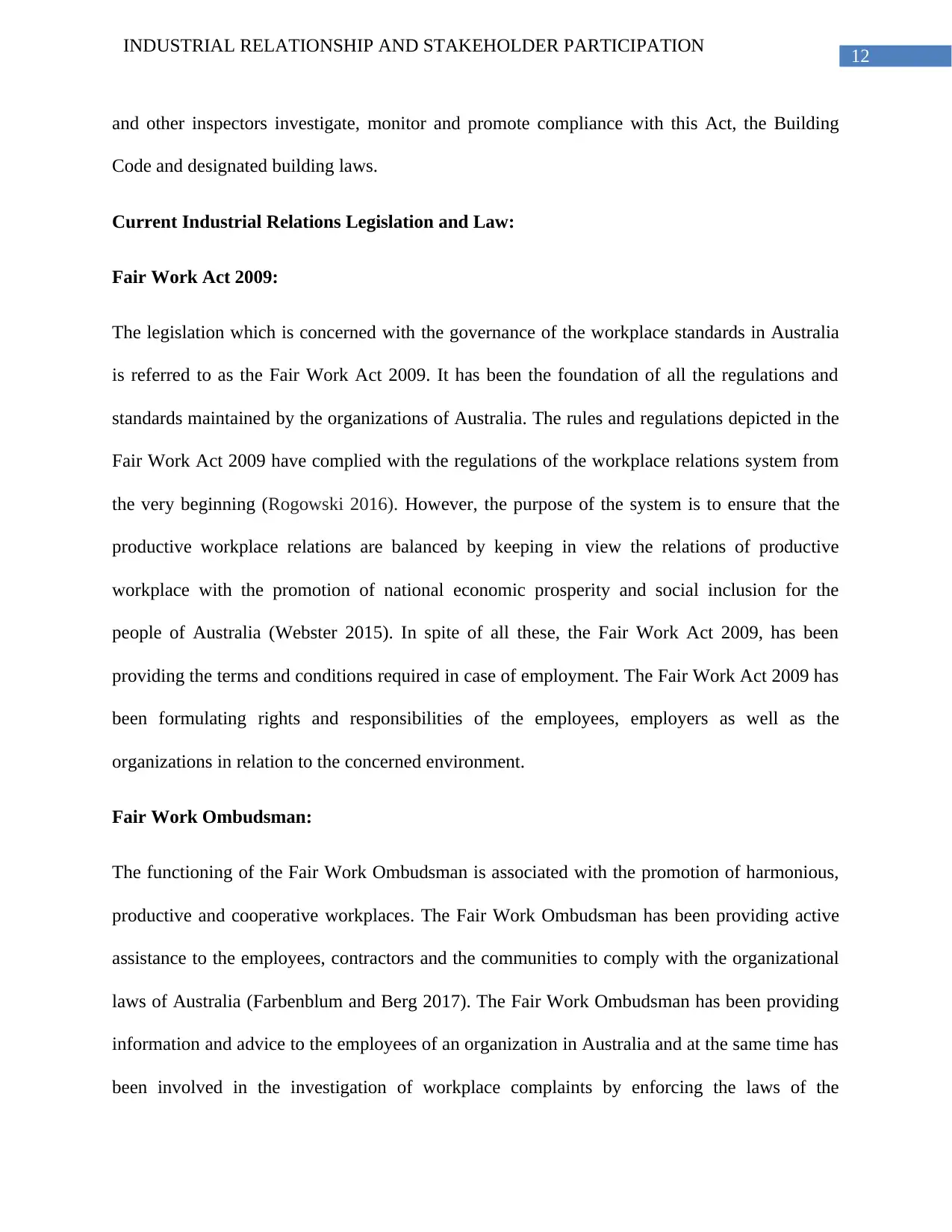
12
INDUSTRIAL RELATIONSHIP AND STAKEHOLDER PARTICIPATION
and other inspectors investigate, monitor and promote compliance with this Act, the Building
Code and designated building laws.
Current Industrial Relations Legislation and Law:
Fair Work Act 2009:
The legislation which is concerned with the governance of the workplace standards in Australia
is referred to as the Fair Work Act 2009. It has been the foundation of all the regulations and
standards maintained by the organizations of Australia. The rules and regulations depicted in the
Fair Work Act 2009 have complied with the regulations of the workplace relations system from
the very beginning (Rogowski 2016). However, the purpose of the system is to ensure that the
productive workplace relations are balanced by keeping in view the relations of productive
workplace with the promotion of national economic prosperity and social inclusion for the
people of Australia (Webster 2015). In spite of all these, the Fair Work Act 2009, has been
providing the terms and conditions required in case of employment. The Fair Work Act 2009 has
been formulating rights and responsibilities of the employees, employers as well as the
organizations in relation to the concerned environment.
Fair Work Ombudsman:
The functioning of the Fair Work Ombudsman is associated with the promotion of harmonious,
productive and cooperative workplaces. The Fair Work Ombudsman has been providing active
assistance to the employees, contractors and the communities to comply with the organizational
laws of Australia (Farbenblum and Berg 2017). The Fair Work Ombudsman has been providing
information and advice to the employees of an organization in Australia and at the same time has
been involved in the investigation of workplace complaints by enforcing the laws of the
INDUSTRIAL RELATIONSHIP AND STAKEHOLDER PARTICIPATION
and other inspectors investigate, monitor and promote compliance with this Act, the Building
Code and designated building laws.
Current Industrial Relations Legislation and Law:
Fair Work Act 2009:
The legislation which is concerned with the governance of the workplace standards in Australia
is referred to as the Fair Work Act 2009. It has been the foundation of all the regulations and
standards maintained by the organizations of Australia. The rules and regulations depicted in the
Fair Work Act 2009 have complied with the regulations of the workplace relations system from
the very beginning (Rogowski 2016). However, the purpose of the system is to ensure that the
productive workplace relations are balanced by keeping in view the relations of productive
workplace with the promotion of national economic prosperity and social inclusion for the
people of Australia (Webster 2015). In spite of all these, the Fair Work Act 2009, has been
providing the terms and conditions required in case of employment. The Fair Work Act 2009 has
been formulating rights and responsibilities of the employees, employers as well as the
organizations in relation to the concerned environment.
Fair Work Ombudsman:
The functioning of the Fair Work Ombudsman is associated with the promotion of harmonious,
productive and cooperative workplaces. The Fair Work Ombudsman has been providing active
assistance to the employees, contractors and the communities to comply with the organizational
laws of Australia (Farbenblum and Berg 2017). The Fair Work Ombudsman has been providing
information and advice to the employees of an organization in Australia and at the same time has
been involved in the investigation of workplace complaints by enforcing the laws of the
Paraphrase This Document
Need a fresh take? Get an instant paraphrase of this document with our AI Paraphraser
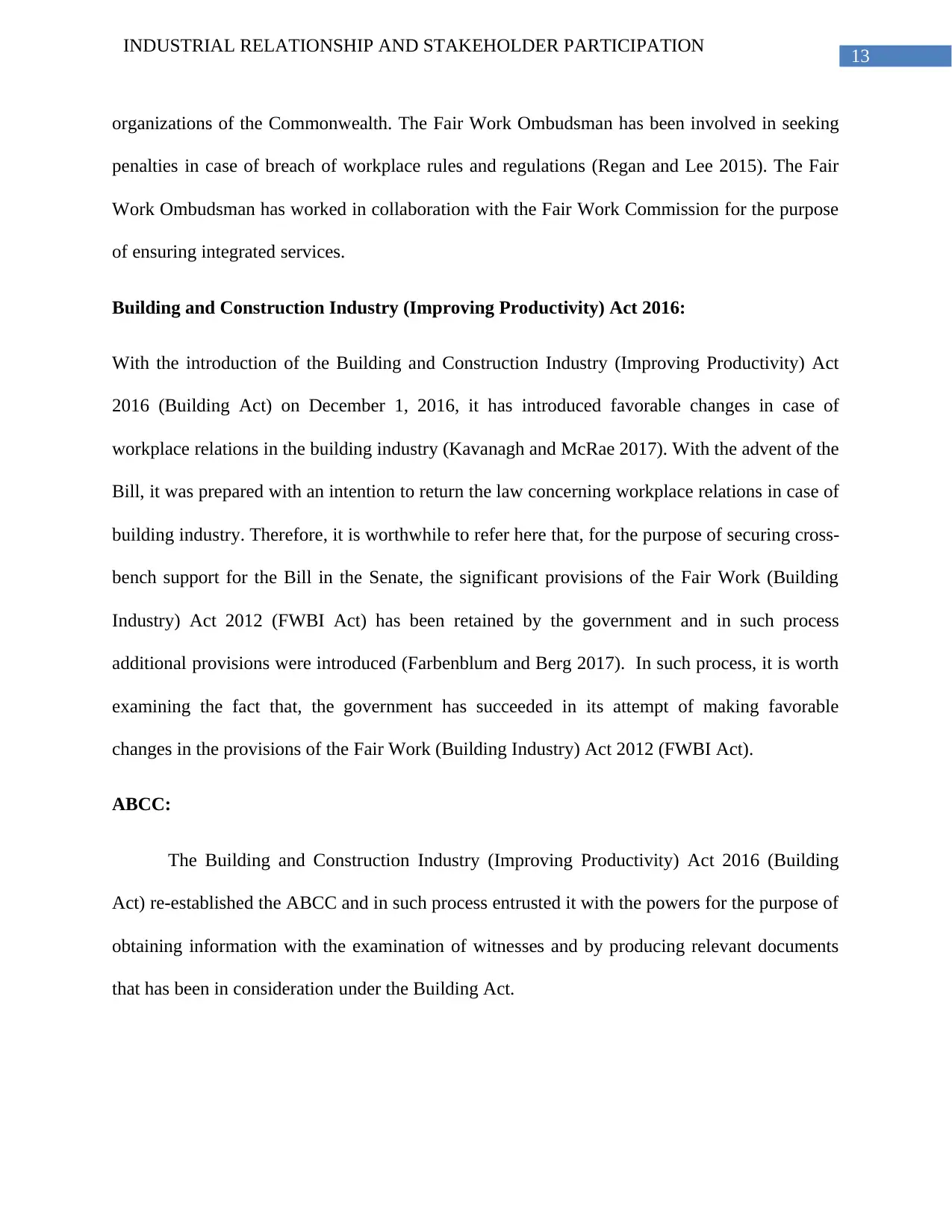
13
INDUSTRIAL RELATIONSHIP AND STAKEHOLDER PARTICIPATION
organizations of the Commonwealth. The Fair Work Ombudsman has been involved in seeking
penalties in case of breach of workplace rules and regulations (Regan and Lee 2015). The Fair
Work Ombudsman has worked in collaboration with the Fair Work Commission for the purpose
of ensuring integrated services.
Building and Construction Industry (Improving Productivity) Act 2016:
With the introduction of the Building and Construction Industry (Improving Productivity) Act
2016 (Building Act) on December 1, 2016, it has introduced favorable changes in case of
workplace relations in the building industry (Kavanagh and McRae 2017). With the advent of the
Bill, it was prepared with an intention to return the law concerning workplace relations in case of
building industry. Therefore, it is worthwhile to refer here that, for the purpose of securing cross-
bench support for the Bill in the Senate, the significant provisions of the Fair Work (Building
Industry) Act 2012 (FWBI Act) has been retained by the government and in such process
additional provisions were introduced (Farbenblum and Berg 2017). In such process, it is worth
examining the fact that, the government has succeeded in its attempt of making favorable
changes in the provisions of the Fair Work (Building Industry) Act 2012 (FWBI Act).
ABCC:
The Building and Construction Industry (Improving Productivity) Act 2016 (Building
Act) re-established the ABCC and in such process entrusted it with the powers for the purpose of
obtaining information with the examination of witnesses and by producing relevant documents
that has been in consideration under the Building Act.
INDUSTRIAL RELATIONSHIP AND STAKEHOLDER PARTICIPATION
organizations of the Commonwealth. The Fair Work Ombudsman has been involved in seeking
penalties in case of breach of workplace rules and regulations (Regan and Lee 2015). The Fair
Work Ombudsman has worked in collaboration with the Fair Work Commission for the purpose
of ensuring integrated services.
Building and Construction Industry (Improving Productivity) Act 2016:
With the introduction of the Building and Construction Industry (Improving Productivity) Act
2016 (Building Act) on December 1, 2016, it has introduced favorable changes in case of
workplace relations in the building industry (Kavanagh and McRae 2017). With the advent of the
Bill, it was prepared with an intention to return the law concerning workplace relations in case of
building industry. Therefore, it is worthwhile to refer here that, for the purpose of securing cross-
bench support for the Bill in the Senate, the significant provisions of the Fair Work (Building
Industry) Act 2012 (FWBI Act) has been retained by the government and in such process
additional provisions were introduced (Farbenblum and Berg 2017). In such process, it is worth
examining the fact that, the government has succeeded in its attempt of making favorable
changes in the provisions of the Fair Work (Building Industry) Act 2012 (FWBI Act).
ABCC:
The Building and Construction Industry (Improving Productivity) Act 2016 (Building
Act) re-established the ABCC and in such process entrusted it with the powers for the purpose of
obtaining information with the examination of witnesses and by producing relevant documents
that has been in consideration under the Building Act.

14
INDUSTRIAL RELATIONSHIP AND STAKEHOLDER PARTICIPATION
Key stakeholders and differing functions:
The key stakeholders of the industrial relationship consists of government of Australia,
the state governments of different states, the trade unions, the employee associations, the
employers’ unions, the corporate organisations in Australia, the workers and the Australian
community as a whole. The following section would explore the role of the different stakeholder
groups as far as industrial relations in Australia is concerned (abc.net.au 2018).
Enforcing bodies:
The Office of the Australian Building and Construction Commissioner is an independent
statutory body which oversees the working of industrial relationship in Australia. The body
provides education on workplace policies, carry out investigations into industrial disputes and
can even initiate legal proceedings, if the cases demands (abcc.gov.au 2018).
State and Federal Governments (Federal Political Parties):
The Federal and the state governments of Australia is one of the key stakeholders in the
industrial relationship of Australia. The government is plays several roles in the Australian
economy which attribute it this important position. Firstly, the government is the policy and law
maker which all industries operating with the market of Australia follow. The government in
Australia forms laws to facilitate the operations of both the employers and the employees, the
other two stakeholders of the industrial relations. For example, the Federal Government of
Australia enacted the Fair Work Act in 2009 to regulate the workplace relations, guarantee
employee safety, assist employees balance between personal and professional lives and to ensure
that the employees receive minimum wages for their work (fairwork.gov.au 2018). The state
governments of the Australian states like Victoria enforce the laws within the respective states to
ensure that they are followed by the employers (vic.awu.net.au 2018). Similarly, the Australian
INDUSTRIAL RELATIONSHIP AND STAKEHOLDER PARTICIPATION
Key stakeholders and differing functions:
The key stakeholders of the industrial relationship consists of government of Australia,
the state governments of different states, the trade unions, the employee associations, the
employers’ unions, the corporate organisations in Australia, the workers and the Australian
community as a whole. The following section would explore the role of the different stakeholder
groups as far as industrial relations in Australia is concerned (abc.net.au 2018).
Enforcing bodies:
The Office of the Australian Building and Construction Commissioner is an independent
statutory body which oversees the working of industrial relationship in Australia. The body
provides education on workplace policies, carry out investigations into industrial disputes and
can even initiate legal proceedings, if the cases demands (abcc.gov.au 2018).
State and Federal Governments (Federal Political Parties):
The Federal and the state governments of Australia is one of the key stakeholders in the
industrial relationship of Australia. The government is plays several roles in the Australian
economy which attribute it this important position. Firstly, the government is the policy and law
maker which all industries operating with the market of Australia follow. The government in
Australia forms laws to facilitate the operations of both the employers and the employees, the
other two stakeholders of the industrial relations. For example, the Federal Government of
Australia enacted the Fair Work Act in 2009 to regulate the workplace relations, guarantee
employee safety, assist employees balance between personal and professional lives and to ensure
that the employees receive minimum wages for their work (fairwork.gov.au 2018). The state
governments of the Australian states like Victoria enforce the laws within the respective states to
ensure that they are followed by the employers (vic.awu.net.au 2018). Similarly, the Australian
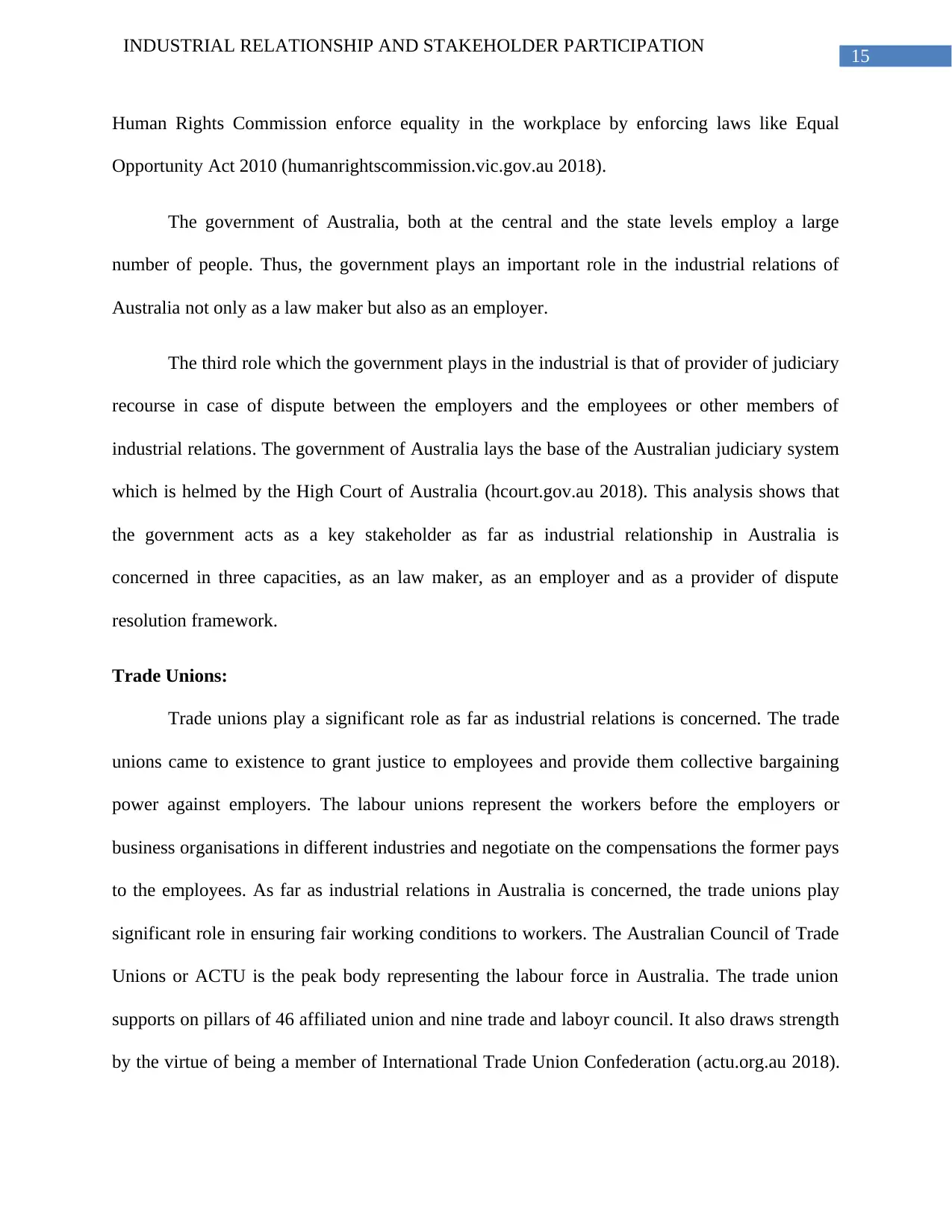
15
INDUSTRIAL RELATIONSHIP AND STAKEHOLDER PARTICIPATION
Human Rights Commission enforce equality in the workplace by enforcing laws like Equal
Opportunity Act 2010 (humanrightscommission.vic.gov.au 2018).
The government of Australia, both at the central and the state levels employ a large
number of people. Thus, the government plays an important role in the industrial relations of
Australia not only as a law maker but also as an employer.
The third role which the government plays in the industrial is that of provider of judiciary
recourse in case of dispute between the employers and the employees or other members of
industrial relations. The government of Australia lays the base of the Australian judiciary system
which is helmed by the High Court of Australia (hcourt.gov.au 2018). This analysis shows that
the government acts as a key stakeholder as far as industrial relationship in Australia is
concerned in three capacities, as an law maker, as an employer and as a provider of dispute
resolution framework.
Trade Unions:
Trade unions play a significant role as far as industrial relations is concerned. The trade
unions came to existence to grant justice to employees and provide them collective bargaining
power against employers. The labour unions represent the workers before the employers or
business organisations in different industries and negotiate on the compensations the former pays
to the employees. As far as industrial relations in Australia is concerned, the trade unions play
significant role in ensuring fair working conditions to workers. The Australian Council of Trade
Unions or ACTU is the peak body representing the labour force in Australia. The trade union
supports on pillars of 46 affiliated union and nine trade and laboyr council. It also draws strength
by the virtue of being a member of International Trade Union Confederation (actu.org.au 2018).
INDUSTRIAL RELATIONSHIP AND STAKEHOLDER PARTICIPATION
Human Rights Commission enforce equality in the workplace by enforcing laws like Equal
Opportunity Act 2010 (humanrightscommission.vic.gov.au 2018).
The government of Australia, both at the central and the state levels employ a large
number of people. Thus, the government plays an important role in the industrial relations of
Australia not only as a law maker but also as an employer.
The third role which the government plays in the industrial is that of provider of judiciary
recourse in case of dispute between the employers and the employees or other members of
industrial relations. The government of Australia lays the base of the Australian judiciary system
which is helmed by the High Court of Australia (hcourt.gov.au 2018). This analysis shows that
the government acts as a key stakeholder as far as industrial relationship in Australia is
concerned in three capacities, as an law maker, as an employer and as a provider of dispute
resolution framework.
Trade Unions:
Trade unions play a significant role as far as industrial relations is concerned. The trade
unions came to existence to grant justice to employees and provide them collective bargaining
power against employers. The labour unions represent the workers before the employers or
business organisations in different industries and negotiate on the compensations the former pays
to the employees. As far as industrial relations in Australia is concerned, the trade unions play
significant role in ensuring fair working conditions to workers. The Australian Council of Trade
Unions or ACTU is the peak body representing the labour force in Australia. The trade union
supports on pillars of 46 affiliated union and nine trade and laboyr council. It also draws strength
by the virtue of being a member of International Trade Union Confederation (actu.org.au 2018).
Secure Best Marks with AI Grader
Need help grading? Try our AI Grader for instant feedback on your assignments.
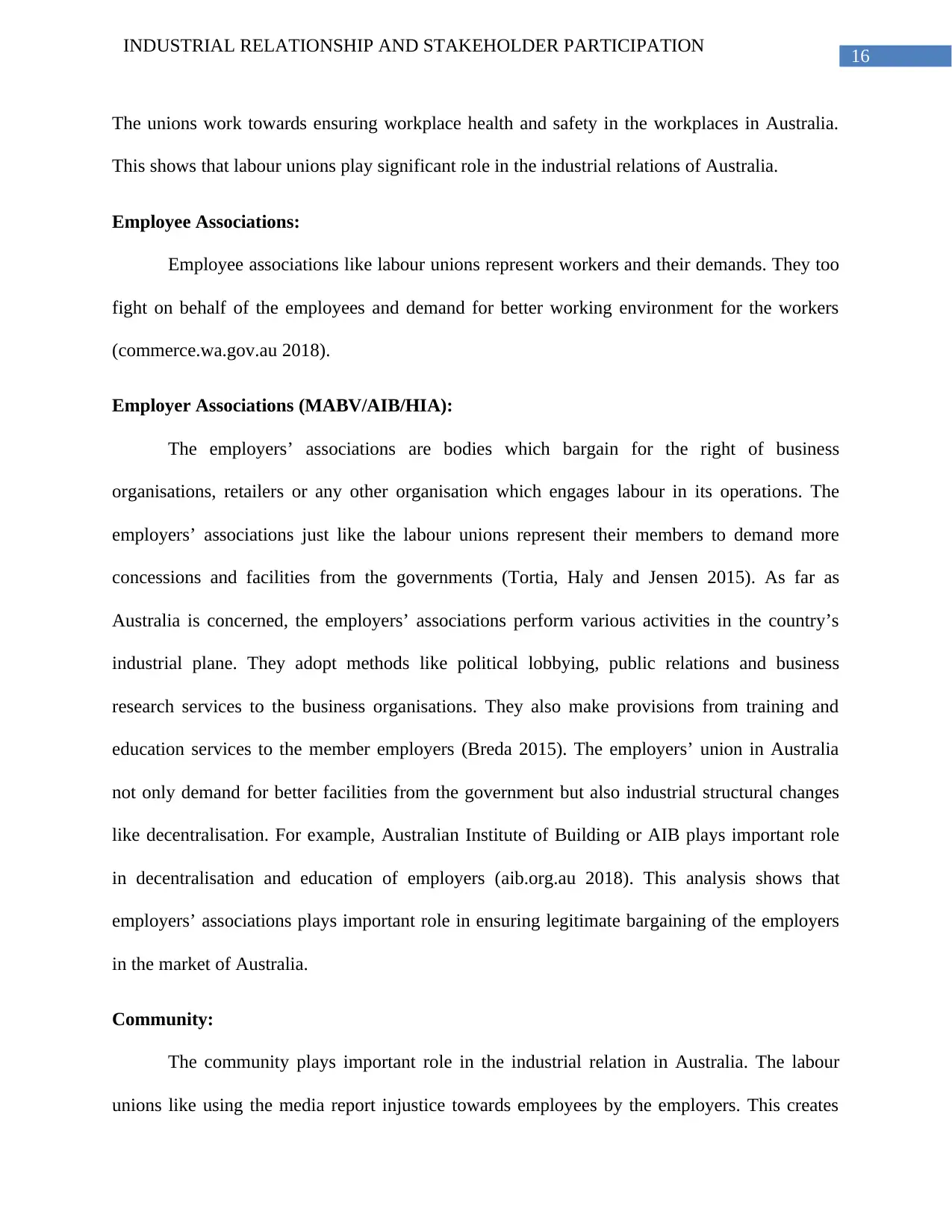
16
INDUSTRIAL RELATIONSHIP AND STAKEHOLDER PARTICIPATION
The unions work towards ensuring workplace health and safety in the workplaces in Australia.
This shows that labour unions play significant role in the industrial relations of Australia.
Employee Associations:
Employee associations like labour unions represent workers and their demands. They too
fight on behalf of the employees and demand for better working environment for the workers
(commerce.wa.gov.au 2018).
Employer Associations (MABV/AIB/HIA):
The employers’ associations are bodies which bargain for the right of business
organisations, retailers or any other organisation which engages labour in its operations. The
employers’ associations just like the labour unions represent their members to demand more
concessions and facilities from the governments (Tortia, Haly and Jensen 2015). As far as
Australia is concerned, the employers’ associations perform various activities in the country’s
industrial plane. They adopt methods like political lobbying, public relations and business
research services to the business organisations. They also make provisions from training and
education services to the member employers (Breda 2015). The employers’ union in Australia
not only demand for better facilities from the government but also industrial structural changes
like decentralisation. For example, Australian Institute of Building or AIB plays important role
in decentralisation and education of employers (aib.org.au 2018). This analysis shows that
employers’ associations plays important role in ensuring legitimate bargaining of the employers
in the market of Australia.
Community:
The community plays important role in the industrial relation in Australia. The labour
unions like using the media report injustice towards employees by the employers. This creates
INDUSTRIAL RELATIONSHIP AND STAKEHOLDER PARTICIPATION
The unions work towards ensuring workplace health and safety in the workplaces in Australia.
This shows that labour unions play significant role in the industrial relations of Australia.
Employee Associations:
Employee associations like labour unions represent workers and their demands. They too
fight on behalf of the employees and demand for better working environment for the workers
(commerce.wa.gov.au 2018).
Employer Associations (MABV/AIB/HIA):
The employers’ associations are bodies which bargain for the right of business
organisations, retailers or any other organisation which engages labour in its operations. The
employers’ associations just like the labour unions represent their members to demand more
concessions and facilities from the governments (Tortia, Haly and Jensen 2015). As far as
Australia is concerned, the employers’ associations perform various activities in the country’s
industrial plane. They adopt methods like political lobbying, public relations and business
research services to the business organisations. They also make provisions from training and
education services to the member employers (Breda 2015). The employers’ union in Australia
not only demand for better facilities from the government but also industrial structural changes
like decentralisation. For example, Australian Institute of Building or AIB plays important role
in decentralisation and education of employers (aib.org.au 2018). This analysis shows that
employers’ associations plays important role in ensuring legitimate bargaining of the employers
in the market of Australia.
Community:
The community plays important role in the industrial relation in Australia. The labour
unions like using the media report injustice towards employees by the employers. This creates

17
INDUSTRIAL RELATIONSHIP AND STAKEHOLDER PARTICIPATION
reactions in the community like boycotting of business organisations and the products. The
business organisations in order to win back support from the community and revive their
goodwill, have to negotiate with the employees (Benvegnú, Haidinger and Sacchetto 2018).
Thus, community plays a very important role in the industrial relations in Australia because it
forms the base of their goodwill. Thus, the employers are compelled to negotiate with the
employees in the face of community actions to keep their goodwill in tact.
Enforcement of legislations:
Current Environment:
The current environment of the industrial relation in Australia in under the impact of
several stakeholders like the government departments, the business organisations, the employers’
associations and the labour unions. The industrial relation plain in Australia is extremely
competitive owing to its immense profitability and strong corporate governance of the
stakeholders. This often leads to clash of interests which leads to dispute. One such dispute took
place in 2013 Victorian Branch of the Construction and General Division of the Construction
Forestry, Mining and Energy Union (CFMEU) banned Boral Limited from supplying
construction material to sites controlled by it. The ban took place because Boral also served
Grocon Pty Limited with CFMEU was in dispute. Boral filed a case with the Supreme Court of
Victoria and the later declared the ban illegal. CFMEU contravened 45D and 45E of the
Competition and Comsumer Act 2010 by imposing the ban. An officer even threatened to
diminish Boral’s market if it kept on serving Grocon. This analysis shows that industrial
relationship in Australia is very complex where employer s’ associations and business
organisation attempt to blackmail their suppliers to gain underserved profits (Ag.gov.au. 2018).
INDUSTRIAL RELATIONSHIP AND STAKEHOLDER PARTICIPATION
reactions in the community like boycotting of business organisations and the products. The
business organisations in order to win back support from the community and revive their
goodwill, have to negotiate with the employees (Benvegnú, Haidinger and Sacchetto 2018).
Thus, community plays a very important role in the industrial relations in Australia because it
forms the base of their goodwill. Thus, the employers are compelled to negotiate with the
employees in the face of community actions to keep their goodwill in tact.
Enforcement of legislations:
Current Environment:
The current environment of the industrial relation in Australia in under the impact of
several stakeholders like the government departments, the business organisations, the employers’
associations and the labour unions. The industrial relation plain in Australia is extremely
competitive owing to its immense profitability and strong corporate governance of the
stakeholders. This often leads to clash of interests which leads to dispute. One such dispute took
place in 2013 Victorian Branch of the Construction and General Division of the Construction
Forestry, Mining and Energy Union (CFMEU) banned Boral Limited from supplying
construction material to sites controlled by it. The ban took place because Boral also served
Grocon Pty Limited with CFMEU was in dispute. Boral filed a case with the Supreme Court of
Victoria and the later declared the ban illegal. CFMEU contravened 45D and 45E of the
Competition and Comsumer Act 2010 by imposing the ban. An officer even threatened to
diminish Boral’s market if it kept on serving Grocon. This analysis shows that industrial
relationship in Australia is very complex where employer s’ associations and business
organisation attempt to blackmail their suppliers to gain underserved profits (Ag.gov.au. 2018).

18
INDUSTRIAL RELATIONSHIP AND STAKEHOLDER PARTICIPATION
Enforcing Bodies and Power-Employer (Employer Associations) vs Employee trade unions
(Trade unions):
The associations of employers and the employees enter into collective bargaining to
ensure healthier workplace relationship. The employers today view their employees as
stakeholders who attribute them their high business performance. The employers today
emphasise on providing facilities like better working conditions and compensations to them
(Korschun 2015). These changes to a great extent have helped in reducing confrontations of the
associations formed by the two groups. If the management fails to resolve the problem, they
report to a more senior body of officers. If unresolved, the case is referred to a independent
conciliator or mediator like the Fair Work Commission which takes up to case to hear it.
Dispute Resolution:
Industrial dispute between employees and employers can be settled in Australia as per the
guidelines provided by mechanisms like the Fair Work. First, a representatives of the employee
under questions meets the direct reporting manager of the employee to discuss the dispute. They
try to resolve the problem and if they fail to do so, they refer to case to the senior management
(fairwork.gov.au 2018).
Wider community:
The community today acts as an important stakeholder and boosts settling of disputes.
This role of the community as an agent of settling disputes was exemplified when three unions of
engineers, baggage and catering staffs and long-haul pilots of Qantas went on strike over
working conditions and compensation. The strike affected 80000 passengers as over 600 flights
had to be cancelled. The strike effected the tourism industry of Australia and the entire
Australian community due to the inconvenience they faced due to cancellation of flights. The
INDUSTRIAL RELATIONSHIP AND STAKEHOLDER PARTICIPATION
Enforcing Bodies and Power-Employer (Employer Associations) vs Employee trade unions
(Trade unions):
The associations of employers and the employees enter into collective bargaining to
ensure healthier workplace relationship. The employers today view their employees as
stakeholders who attribute them their high business performance. The employers today
emphasise on providing facilities like better working conditions and compensations to them
(Korschun 2015). These changes to a great extent have helped in reducing confrontations of the
associations formed by the two groups. If the management fails to resolve the problem, they
report to a more senior body of officers. If unresolved, the case is referred to a independent
conciliator or mediator like the Fair Work Commission which takes up to case to hear it.
Dispute Resolution:
Industrial dispute between employees and employers can be settled in Australia as per the
guidelines provided by mechanisms like the Fair Work. First, a representatives of the employee
under questions meets the direct reporting manager of the employee to discuss the dispute. They
try to resolve the problem and if they fail to do so, they refer to case to the senior management
(fairwork.gov.au 2018).
Wider community:
The community today acts as an important stakeholder and boosts settling of disputes.
This role of the community as an agent of settling disputes was exemplified when three unions of
engineers, baggage and catering staffs and long-haul pilots of Qantas went on strike over
working conditions and compensation. The strike affected 80000 passengers as over 600 flights
had to be cancelled. The strike effected the tourism industry of Australia and the entire
Australian community due to the inconvenience they faced due to cancellation of flights. The
Paraphrase This Document
Need a fresh take? Get an instant paraphrase of this document with our AI Paraphraser

19
INDUSTRIAL RELATIONSHIP AND STAKEHOLDER PARTICIPATION
Fair Work Australia ordered the airline company to resolve the dispute and resume its services.
An analysis of this resolution would clearly show that resolutions of disputes have economic
benefits (abc.net.au 2018). The disputing employees and employers after resolving the disputes
can resume productivity. This again starts generating revenue for the business organisation and
the economy as a whole.
Economy:
Healthy industrial relations in Australia and adoption of fair Work Act in Australia has
promoted economic development (Herrera 2015). For example, as per Australian Bureau of
Statistics, the mining industry has grown by 38.2 percent while the manufacturing industry has
fallen by 3.4 percent (abs.gov.au 2018).
Politics of State and Commonwealth governments:
The politics of Government of Australia and the states is also responsible for the
industrial relationship in the country. They emphasise on settling of disputes between the
employees and the employers to ensure more productivity. This leads to more stable economy
and get more public support to win elections. Thus, today politics acts a catalyst for settling
industrial disputes and ensuring more healthy industrial relations.
Future of Australian Industrial Relations:
Current Liberal Government:
The current government of Australia is liberal and encourage more participation of
employees and employers in settling disputes. The government makes laws to ensure reduction
of exploitation of employees in the hands of the employers and more congenial working
environment.
INDUSTRIAL RELATIONSHIP AND STAKEHOLDER PARTICIPATION
Fair Work Australia ordered the airline company to resolve the dispute and resume its services.
An analysis of this resolution would clearly show that resolutions of disputes have economic
benefits (abc.net.au 2018). The disputing employees and employers after resolving the disputes
can resume productivity. This again starts generating revenue for the business organisation and
the economy as a whole.
Economy:
Healthy industrial relations in Australia and adoption of fair Work Act in Australia has
promoted economic development (Herrera 2015). For example, as per Australian Bureau of
Statistics, the mining industry has grown by 38.2 percent while the manufacturing industry has
fallen by 3.4 percent (abs.gov.au 2018).
Politics of State and Commonwealth governments:
The politics of Government of Australia and the states is also responsible for the
industrial relationship in the country. They emphasise on settling of disputes between the
employees and the employers to ensure more productivity. This leads to more stable economy
and get more public support to win elections. Thus, today politics acts a catalyst for settling
industrial disputes and ensuring more healthy industrial relations.
Future of Australian Industrial Relations:
Current Liberal Government:
The current government of Australia is liberal and encourage more participation of
employees and employers in settling disputes. The government makes laws to ensure reduction
of exploitation of employees in the hands of the employers and more congenial working
environment.
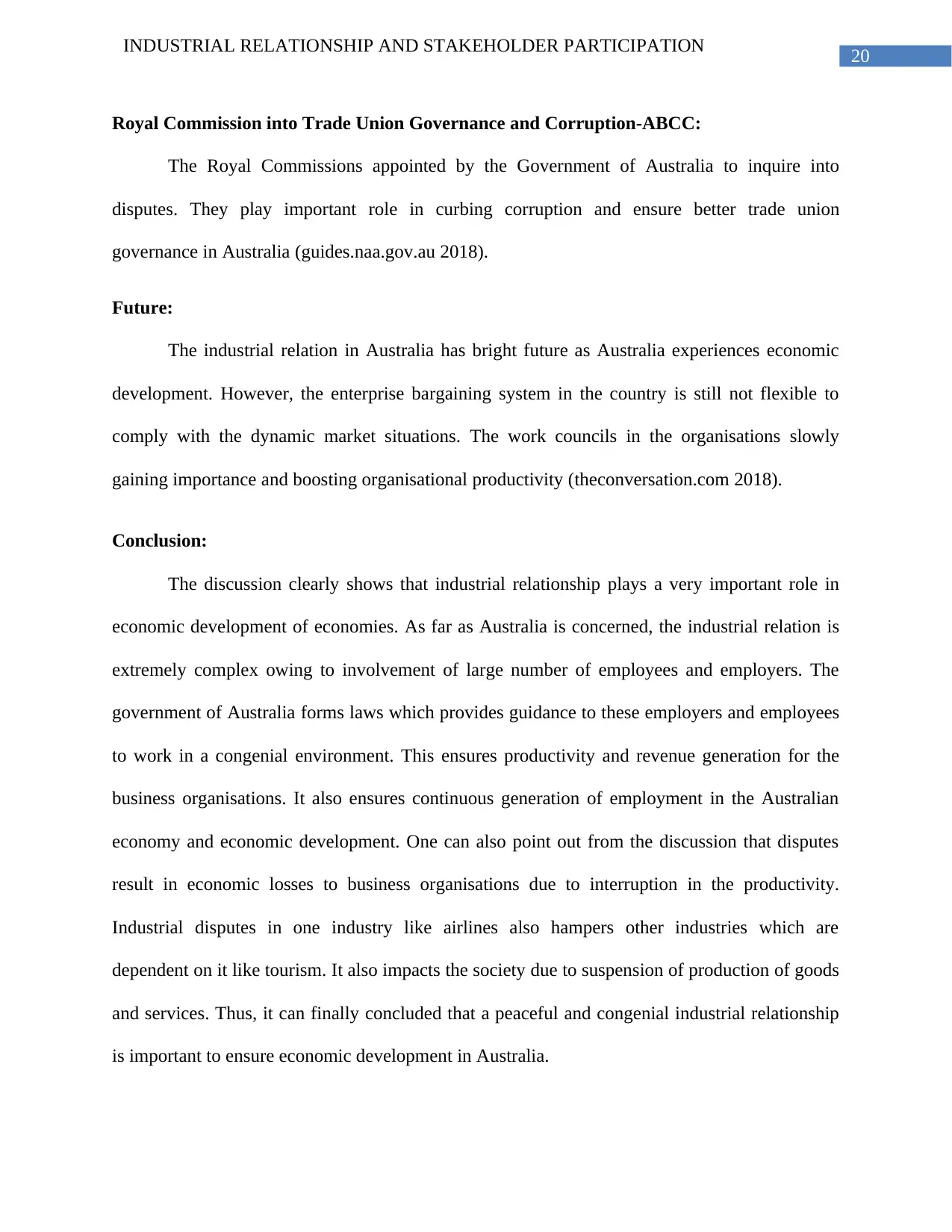
20
INDUSTRIAL RELATIONSHIP AND STAKEHOLDER PARTICIPATION
Royal Commission into Trade Union Governance and Corruption-ABCC:
The Royal Commissions appointed by the Government of Australia to inquire into
disputes. They play important role in curbing corruption and ensure better trade union
governance in Australia (guides.naa.gov.au 2018).
Future:
The industrial relation in Australia has bright future as Australia experiences economic
development. However, the enterprise bargaining system in the country is still not flexible to
comply with the dynamic market situations. The work councils in the organisations slowly
gaining importance and boosting organisational productivity (theconversation.com 2018).
Conclusion:
The discussion clearly shows that industrial relationship plays a very important role in
economic development of economies. As far as Australia is concerned, the industrial relation is
extremely complex owing to involvement of large number of employees and employers. The
government of Australia forms laws which provides guidance to these employers and employees
to work in a congenial environment. This ensures productivity and revenue generation for the
business organisations. It also ensures continuous generation of employment in the Australian
economy and economic development. One can also point out from the discussion that disputes
result in economic losses to business organisations due to interruption in the productivity.
Industrial disputes in one industry like airlines also hampers other industries which are
dependent on it like tourism. It also impacts the society due to suspension of production of goods
and services. Thus, it can finally concluded that a peaceful and congenial industrial relationship
is important to ensure economic development in Australia.
INDUSTRIAL RELATIONSHIP AND STAKEHOLDER PARTICIPATION
Royal Commission into Trade Union Governance and Corruption-ABCC:
The Royal Commissions appointed by the Government of Australia to inquire into
disputes. They play important role in curbing corruption and ensure better trade union
governance in Australia (guides.naa.gov.au 2018).
Future:
The industrial relation in Australia has bright future as Australia experiences economic
development. However, the enterprise bargaining system in the country is still not flexible to
comply with the dynamic market situations. The work councils in the organisations slowly
gaining importance and boosting organisational productivity (theconversation.com 2018).
Conclusion:
The discussion clearly shows that industrial relationship plays a very important role in
economic development of economies. As far as Australia is concerned, the industrial relation is
extremely complex owing to involvement of large number of employees and employers. The
government of Australia forms laws which provides guidance to these employers and employees
to work in a congenial environment. This ensures productivity and revenue generation for the
business organisations. It also ensures continuous generation of employment in the Australian
economy and economic development. One can also point out from the discussion that disputes
result in economic losses to business organisations due to interruption in the productivity.
Industrial disputes in one industry like airlines also hampers other industries which are
dependent on it like tourism. It also impacts the society due to suspension of production of goods
and services. Thus, it can finally concluded that a peaceful and congenial industrial relationship
is important to ensure economic development in Australia.

21
INDUSTRIAL RELATIONSHIP AND STAKEHOLDER PARTICIPATION
INDUSTRIAL RELATIONSHIP AND STAKEHOLDER PARTICIPATION
Secure Best Marks with AI Grader
Need help grading? Try our AI Grader for instant feedback on your assignments.

22
INDUSTRIAL RELATIONSHIP AND STAKEHOLDER PARTICIPATION
References:
ABC News. 2018. Qantas to fly again after Fair Work terminates dispute. [online] Available at:
http://www.abc.net.au/news/2011-10-31/qantas-action-terminated-fair-work-rules/3609158
[Accessed 25 May 2018].
Abcc.gov.au. 2018. ABCC. [online] Available at: https://www.abcc.gov.au/ [Accessed 25 May
2018].
Abs.gov.au. 2018. 8155.0 - Australian Industry, 2016-17. [online] Available at:
http://www.abs.gov.au/ausstats/abs@.nsf/mf/8155.0 [Accessed 25 May 2018].
Actu.org.au. 2018. Australian Council of Trade Unions ACTU. [online] Available at:
https://www.actu.org.au/ [Accessed 25 May 2018].
Ag.gov.au. 2018. Search Center : migration. [online] Available at:
https://www.ag.gov.au/Search/results.aspx?k=migration&IsPost=TRUE&similarto=%5Bcfmeu
%2C%201%5D%5Bboral%2C%200.989355%5D%5Bgrocon%2C%200.564645%5D
%5Bcommission%2C%200.502933%5D%5Bevidence%2C%200.501762%5D%5Bsupreme
%20court%2C%200.491097%5D%5Bsetka%2C%200.466527%5D%5Bboral%20concrete%2C
%200.383482%5D%5Bwitness%20statement%2C%200.383482%5D%5Bcourt%20proceeding
%2C%200.375735%5D%5Bdalton%2C%200.375735%5D%5Bcfmeu%20shop%2C
%200.342997%5D%5Bhead%2C%200.328991%5D%5Bpeter%20head%2C%200.325396%5D
%5Bboral%20customers%2C%200.325396%5D&similartype=find&r=format%3D
%22AQlBZG9iZSBQREYGZm9ybWF0AQJeIgIiJA%3D%3D%22%20write%3D
%22AQdFYXJsaWVyBXdyaXRlABcBWzsyMDE1LTEwLTMxVDIzOjU5OjU5Wl0%3D%22
[Accessed 25 May 2018].
INDUSTRIAL RELATIONSHIP AND STAKEHOLDER PARTICIPATION
References:
ABC News. 2018. Qantas to fly again after Fair Work terminates dispute. [online] Available at:
http://www.abc.net.au/news/2011-10-31/qantas-action-terminated-fair-work-rules/3609158
[Accessed 25 May 2018].
Abcc.gov.au. 2018. ABCC. [online] Available at: https://www.abcc.gov.au/ [Accessed 25 May
2018].
Abs.gov.au. 2018. 8155.0 - Australian Industry, 2016-17. [online] Available at:
http://www.abs.gov.au/ausstats/abs@.nsf/mf/8155.0 [Accessed 25 May 2018].
Actu.org.au. 2018. Australian Council of Trade Unions ACTU. [online] Available at:
https://www.actu.org.au/ [Accessed 25 May 2018].
Ag.gov.au. 2018. Search Center : migration. [online] Available at:
https://www.ag.gov.au/Search/results.aspx?k=migration&IsPost=TRUE&similarto=%5Bcfmeu
%2C%201%5D%5Bboral%2C%200.989355%5D%5Bgrocon%2C%200.564645%5D
%5Bcommission%2C%200.502933%5D%5Bevidence%2C%200.501762%5D%5Bsupreme
%20court%2C%200.491097%5D%5Bsetka%2C%200.466527%5D%5Bboral%20concrete%2C
%200.383482%5D%5Bwitness%20statement%2C%200.383482%5D%5Bcourt%20proceeding
%2C%200.375735%5D%5Bdalton%2C%200.375735%5D%5Bcfmeu%20shop%2C
%200.342997%5D%5Bhead%2C%200.328991%5D%5Bpeter%20head%2C%200.325396%5D
%5Bboral%20customers%2C%200.325396%5D&similartype=find&r=format%3D
%22AQlBZG9iZSBQREYGZm9ybWF0AQJeIgIiJA%3D%3D%22%20write%3D
%22AQdFYXJsaWVyBXdyaXRlABcBWzsyMDE1LTEwLTMxVDIzOjU5OjU5Wl0%3D%22
[Accessed 25 May 2018].
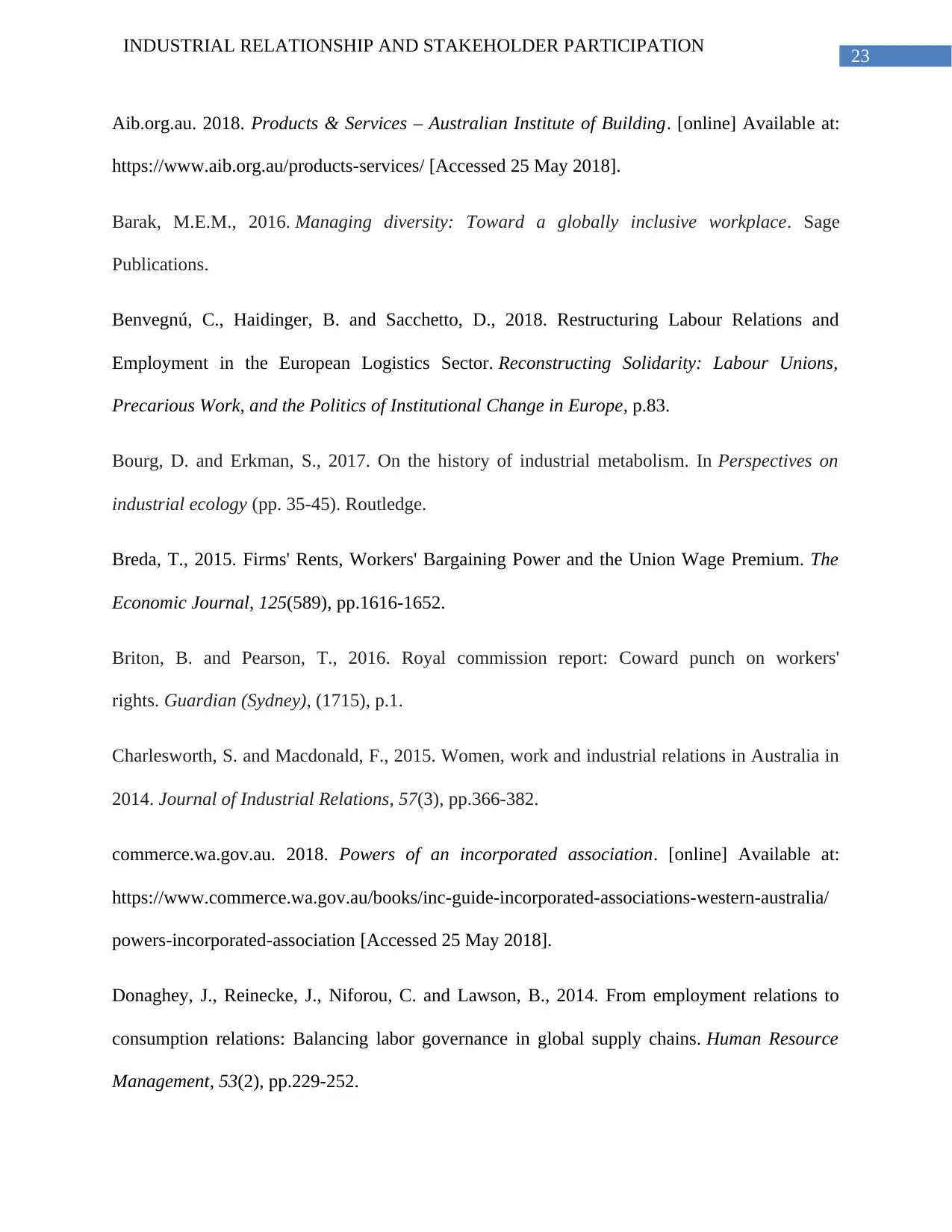
23
INDUSTRIAL RELATIONSHIP AND STAKEHOLDER PARTICIPATION
Aib.org.au. 2018. Products & Services – Australian Institute of Building. [online] Available at:
https://www.aib.org.au/products-services/ [Accessed 25 May 2018].
Barak, M.E.M., 2016. Managing diversity: Toward a globally inclusive workplace. Sage
Publications.
Benvegnú, C., Haidinger, B. and Sacchetto, D., 2018. Restructuring Labour Relations and
Employment in the European Logistics Sector. Reconstructing Solidarity: Labour Unions,
Precarious Work, and the Politics of Institutional Change in Europe, p.83.
Bourg, D. and Erkman, S., 2017. On the history of industrial metabolism. In Perspectives on
industrial ecology (pp. 35-45). Routledge.
Breda, T., 2015. Firms' Rents, Workers' Bargaining Power and the Union Wage Premium. The
Economic Journal, 125(589), pp.1616-1652.
Briton, B. and Pearson, T., 2016. Royal commission report: Coward punch on workers'
rights. Guardian (Sydney), (1715), p.1.
Charlesworth, S. and Macdonald, F., 2015. Women, work and industrial relations in Australia in
2014. Journal of Industrial Relations, 57(3), pp.366-382.
commerce.wa.gov.au. 2018. Powers of an incorporated association. [online] Available at:
https://www.commerce.wa.gov.au/books/inc-guide-incorporated-associations-western-australia/
powers-incorporated-association [Accessed 25 May 2018].
Donaghey, J., Reinecke, J., Niforou, C. and Lawson, B., 2014. From employment relations to
consumption relations: Balancing labor governance in global supply chains. Human Resource
Management, 53(2), pp.229-252.
INDUSTRIAL RELATIONSHIP AND STAKEHOLDER PARTICIPATION
Aib.org.au. 2018. Products & Services – Australian Institute of Building. [online] Available at:
https://www.aib.org.au/products-services/ [Accessed 25 May 2018].
Barak, M.E.M., 2016. Managing diversity: Toward a globally inclusive workplace. Sage
Publications.
Benvegnú, C., Haidinger, B. and Sacchetto, D., 2018. Restructuring Labour Relations and
Employment in the European Logistics Sector. Reconstructing Solidarity: Labour Unions,
Precarious Work, and the Politics of Institutional Change in Europe, p.83.
Bourg, D. and Erkman, S., 2017. On the history of industrial metabolism. In Perspectives on
industrial ecology (pp. 35-45). Routledge.
Breda, T., 2015. Firms' Rents, Workers' Bargaining Power and the Union Wage Premium. The
Economic Journal, 125(589), pp.1616-1652.
Briton, B. and Pearson, T., 2016. Royal commission report: Coward punch on workers'
rights. Guardian (Sydney), (1715), p.1.
Charlesworth, S. and Macdonald, F., 2015. Women, work and industrial relations in Australia in
2014. Journal of Industrial Relations, 57(3), pp.366-382.
commerce.wa.gov.au. 2018. Powers of an incorporated association. [online] Available at:
https://www.commerce.wa.gov.au/books/inc-guide-incorporated-associations-western-australia/
powers-incorporated-association [Accessed 25 May 2018].
Donaghey, J., Reinecke, J., Niforou, C. and Lawson, B., 2014. From employment relations to
consumption relations: Balancing labor governance in global supply chains. Human Resource
Management, 53(2), pp.229-252.

24
INDUSTRIAL RELATIONSHIP AND STAKEHOLDER PARTICIPATION
Edwards, T., Sanchez‐Mangas, R., Bélanger, J. and McDonnell, A., 2015. Why are some
subsidiaries of multinationals the source of novel practices while others are not? National,
corporate and functional influences. British Journal of Management, 26(2), pp.146-162.
Fair Work Ombudsman. 2018. Welcome to the Fair Work Ombudsman website. [online]
Available at: https://www.fairwork.gov.au/ [Accessed 23 May 2018].
Farbenblum, B. and Berg, L., 2017. Migrant workers’ access to remedy for exploitation in
Australia: the role of the national Fair Work Ombudsman. Australian Journal of Human Rights,
pp.1-22.
Freedland, M., Bogg, A., Cabrelli, D., Collins, H., Countouris, N., Davies, A.C.L., Deakin, S.
and Prassl, J. eds., 2016. The contract of employment. Oxford University Press.
Guides.naa.gov.au. 2018. Industrial relations - Commonwealth Government Records about
South Australia. [online] Available at:
http://guides.naa.gov.au/records-about-south-australia/chapter11/industrial-relations.aspx
[Accessed 25 May 2018].
Hcourt.gov.au. 2018. Role of the High Court - High Court of Australia. [online] Available at:
http://www.hcourt.gov.au/about/role-of-the-high-court [Accessed 25 May 2018].
Herrera, M.E.B., 2015. Creating competitive advantage by institutionalizing corporate social
innovation. Journal of Business Research, 68(7), pp.1468-1474.
Horberry, T., Burgess-Limerick, R., Steiner, L., Barone, T.L., Patts, J.R., Janisko, S.J., Colinet,
J.F., Patts, L.D., Beck, T.W., Mischler, S.E. and Bernard, B.P., 2018. The potential impact of
light emitting diode lighting on reducing mining injuries during operation and maintenance of
INDUSTRIAL RELATIONSHIP AND STAKEHOLDER PARTICIPATION
Edwards, T., Sanchez‐Mangas, R., Bélanger, J. and McDonnell, A., 2015. Why are some
subsidiaries of multinationals the source of novel practices while others are not? National,
corporate and functional influences. British Journal of Management, 26(2), pp.146-162.
Fair Work Ombudsman. 2018. Welcome to the Fair Work Ombudsman website. [online]
Available at: https://www.fairwork.gov.au/ [Accessed 23 May 2018].
Farbenblum, B. and Berg, L., 2017. Migrant workers’ access to remedy for exploitation in
Australia: the role of the national Fair Work Ombudsman. Australian Journal of Human Rights,
pp.1-22.
Freedland, M., Bogg, A., Cabrelli, D., Collins, H., Countouris, N., Davies, A.C.L., Deakin, S.
and Prassl, J. eds., 2016. The contract of employment. Oxford University Press.
Guides.naa.gov.au. 2018. Industrial relations - Commonwealth Government Records about
South Australia. [online] Available at:
http://guides.naa.gov.au/records-about-south-australia/chapter11/industrial-relations.aspx
[Accessed 25 May 2018].
Hcourt.gov.au. 2018. Role of the High Court - High Court of Australia. [online] Available at:
http://www.hcourt.gov.au/about/role-of-the-high-court [Accessed 25 May 2018].
Herrera, M.E.B., 2015. Creating competitive advantage by institutionalizing corporate social
innovation. Journal of Business Research, 68(7), pp.1468-1474.
Horberry, T., Burgess-Limerick, R., Steiner, L., Barone, T.L., Patts, J.R., Janisko, S.J., Colinet,
J.F., Patts, L.D., Beck, T.W., Mischler, S.E. and Bernard, B.P., 2018. The potential impact of
light emitting diode lighting on reducing mining injuries during operation and maintenance of
Paraphrase This Document
Need a fresh take? Get an instant paraphrase of this document with our AI Paraphraser
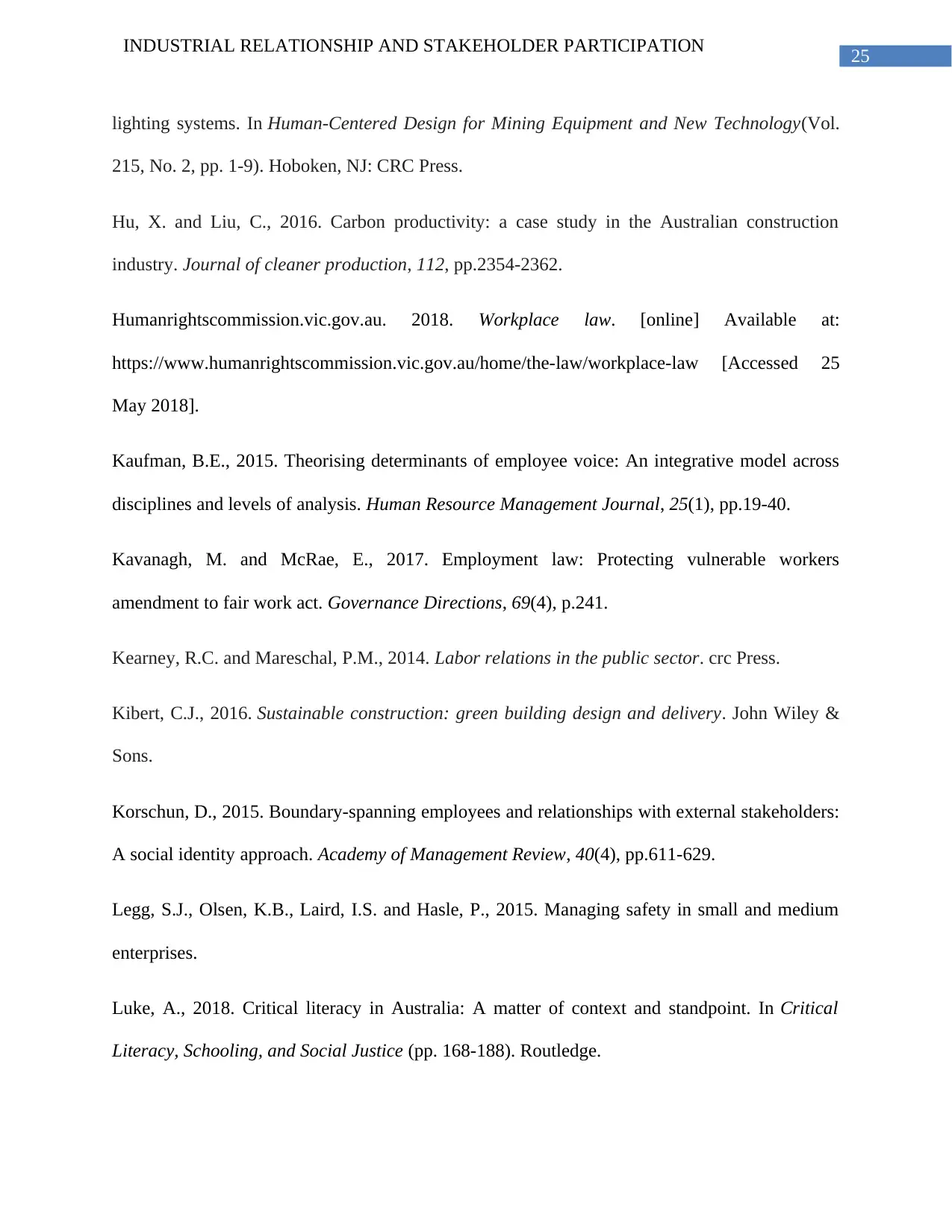
25
INDUSTRIAL RELATIONSHIP AND STAKEHOLDER PARTICIPATION
lighting systems. In Human-Centered Design for Mining Equipment and New Technology(Vol.
215, No. 2, pp. 1-9). Hoboken, NJ: CRC Press.
Hu, X. and Liu, C., 2016. Carbon productivity: a case study in the Australian construction
industry. Journal of cleaner production, 112, pp.2354-2362.
Humanrightscommission.vic.gov.au. 2018. Workplace law. [online] Available at:
https://www.humanrightscommission.vic.gov.au/home/the-law/workplace-law [Accessed 25
May 2018].
Kaufman, B.E., 2015. Theorising determinants of employee voice: An integrative model across
disciplines and levels of analysis. Human Resource Management Journal, 25(1), pp.19-40.
Kavanagh, M. and McRae, E., 2017. Employment law: Protecting vulnerable workers
amendment to fair work act. Governance Directions, 69(4), p.241.
Kearney, R.C. and Mareschal, P.M., 2014. Labor relations in the public sector. crc Press.
Kibert, C.J., 2016. Sustainable construction: green building design and delivery. John Wiley &
Sons.
Korschun, D., 2015. Boundary-spanning employees and relationships with external stakeholders:
A social identity approach. Academy of Management Review, 40(4), pp.611-629.
Legg, S.J., Olsen, K.B., Laird, I.S. and Hasle, P., 2015. Managing safety in small and medium
enterprises.
Luke, A., 2018. Critical literacy in Australia: A matter of context and standpoint. In Critical
Literacy, Schooling, and Social Justice (pp. 168-188). Routledge.
INDUSTRIAL RELATIONSHIP AND STAKEHOLDER PARTICIPATION
lighting systems. In Human-Centered Design for Mining Equipment and New Technology(Vol.
215, No. 2, pp. 1-9). Hoboken, NJ: CRC Press.
Hu, X. and Liu, C., 2016. Carbon productivity: a case study in the Australian construction
industry. Journal of cleaner production, 112, pp.2354-2362.
Humanrightscommission.vic.gov.au. 2018. Workplace law. [online] Available at:
https://www.humanrightscommission.vic.gov.au/home/the-law/workplace-law [Accessed 25
May 2018].
Kaufman, B.E., 2015. Theorising determinants of employee voice: An integrative model across
disciplines and levels of analysis. Human Resource Management Journal, 25(1), pp.19-40.
Kavanagh, M. and McRae, E., 2017. Employment law: Protecting vulnerable workers
amendment to fair work act. Governance Directions, 69(4), p.241.
Kearney, R.C. and Mareschal, P.M., 2014. Labor relations in the public sector. crc Press.
Kibert, C.J., 2016. Sustainable construction: green building design and delivery. John Wiley &
Sons.
Korschun, D., 2015. Boundary-spanning employees and relationships with external stakeholders:
A social identity approach. Academy of Management Review, 40(4), pp.611-629.
Legg, S.J., Olsen, K.B., Laird, I.S. and Hasle, P., 2015. Managing safety in small and medium
enterprises.
Luke, A., 2018. Critical literacy in Australia: A matter of context and standpoint. In Critical
Literacy, Schooling, and Social Justice (pp. 168-188). Routledge.
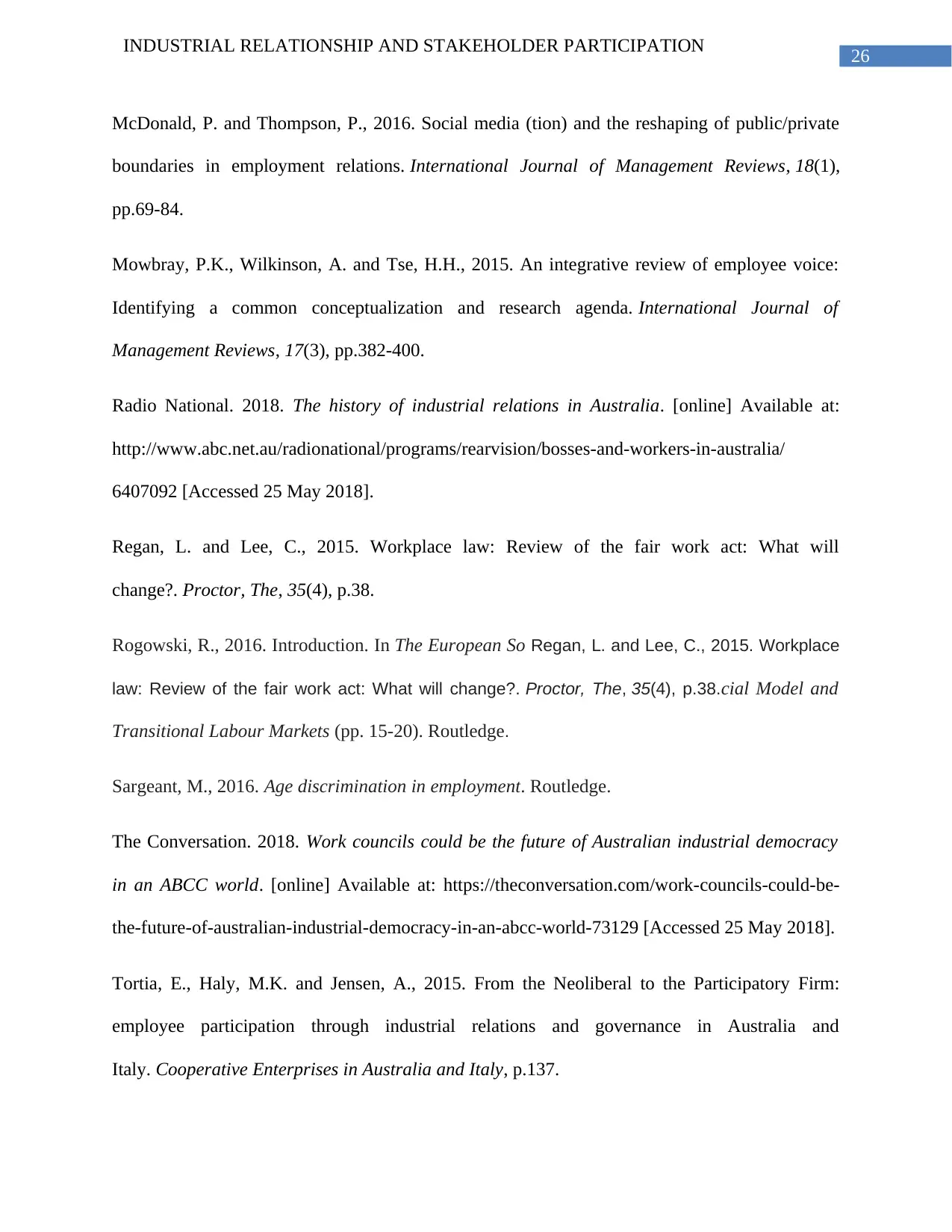
26
INDUSTRIAL RELATIONSHIP AND STAKEHOLDER PARTICIPATION
McDonald, P. and Thompson, P., 2016. Social media (tion) and the reshaping of public/private
boundaries in employment relations. International Journal of Management Reviews, 18(1),
pp.69-84.
Mowbray, P.K., Wilkinson, A. and Tse, H.H., 2015. An integrative review of employee voice:
Identifying a common conceptualization and research agenda. International Journal of
Management Reviews, 17(3), pp.382-400.
Radio National. 2018. The history of industrial relations in Australia. [online] Available at:
http://www.abc.net.au/radionational/programs/rearvision/bosses-and-workers-in-australia/
6407092 [Accessed 25 May 2018].
Regan, L. and Lee, C., 2015. Workplace law: Review of the fair work act: What will
change?. Proctor, The, 35(4), p.38.
Rogowski, R., 2016. Introduction. In The European So Regan, L. and Lee, C., 2015. Workplace
law: Review of the fair work act: What will change?. Proctor, The, 35(4), p.38.cial Model and
Transitional Labour Markets (pp. 15-20). Routledge.
Sargeant, M., 2016. Age discrimination in employment. Routledge.
The Conversation. 2018. Work councils could be the future of Australian industrial democracy
in an ABCC world. [online] Available at: https://theconversation.com/work-councils-could-be-
the-future-of-australian-industrial-democracy-in-an-abcc-world-73129 [Accessed 25 May 2018].
Tortia, E., Haly, M.K. and Jensen, A., 2015. From the Neoliberal to the Participatory Firm:
employee participation through industrial relations and governance in Australia and
Italy. Cooperative Enterprises in Australia and Italy, p.137.
INDUSTRIAL RELATIONSHIP AND STAKEHOLDER PARTICIPATION
McDonald, P. and Thompson, P., 2016. Social media (tion) and the reshaping of public/private
boundaries in employment relations. International Journal of Management Reviews, 18(1),
pp.69-84.
Mowbray, P.K., Wilkinson, A. and Tse, H.H., 2015. An integrative review of employee voice:
Identifying a common conceptualization and research agenda. International Journal of
Management Reviews, 17(3), pp.382-400.
Radio National. 2018. The history of industrial relations in Australia. [online] Available at:
http://www.abc.net.au/radionational/programs/rearvision/bosses-and-workers-in-australia/
6407092 [Accessed 25 May 2018].
Regan, L. and Lee, C., 2015. Workplace law: Review of the fair work act: What will
change?. Proctor, The, 35(4), p.38.
Rogowski, R., 2016. Introduction. In The European So Regan, L. and Lee, C., 2015. Workplace
law: Review of the fair work act: What will change?. Proctor, The, 35(4), p.38.cial Model and
Transitional Labour Markets (pp. 15-20). Routledge.
Sargeant, M., 2016. Age discrimination in employment. Routledge.
The Conversation. 2018. Work councils could be the future of Australian industrial democracy
in an ABCC world. [online] Available at: https://theconversation.com/work-councils-could-be-
the-future-of-australian-industrial-democracy-in-an-abcc-world-73129 [Accessed 25 May 2018].
Tortia, E., Haly, M.K. and Jensen, A., 2015. From the Neoliberal to the Participatory Firm:
employee participation through industrial relations and governance in Australia and
Italy. Cooperative Enterprises in Australia and Italy, p.137.

27
INDUSTRIAL RELATIONSHIP AND STAKEHOLDER PARTICIPATION
Vic.awu.net.au. 2018. Fair Work Act | AWU Victoria. [online] Available at:
https://vic.awu.net.au/fair-work-act [Accessed 25 May 2018]..
Webster, J., 2015. Whose trolley now?: Workplace liability moves up the supply chain. Proctor,
The, 35(4), p.16.
Weller, S. and O’Neill, P., 2014. An argument with neoliberalism: Australia’s place in a global
imaginary. Dialogues in Human Geography, 4(2), pp.105-130.
Wright, C.F. and Lansbury, R.D., 2014. Trade unions and economic reform in Australia, 1983–
2013. The Singapore Economic Review, 59(04), p.1450033.
INDUSTRIAL RELATIONSHIP AND STAKEHOLDER PARTICIPATION
Vic.awu.net.au. 2018. Fair Work Act | AWU Victoria. [online] Available at:
https://vic.awu.net.au/fair-work-act [Accessed 25 May 2018]..
Webster, J., 2015. Whose trolley now?: Workplace liability moves up the supply chain. Proctor,
The, 35(4), p.16.
Weller, S. and O’Neill, P., 2014. An argument with neoliberalism: Australia’s place in a global
imaginary. Dialogues in Human Geography, 4(2), pp.105-130.
Wright, C.F. and Lansbury, R.D., 2014. Trade unions and economic reform in Australia, 1983–
2013. The Singapore Economic Review, 59(04), p.1450033.
1 out of 28
Related Documents
Your All-in-One AI-Powered Toolkit for Academic Success.
+13062052269
info@desklib.com
Available 24*7 on WhatsApp / Email
![[object Object]](/_next/static/media/star-bottom.7253800d.svg)
Unlock your academic potential
© 2024 | Zucol Services PVT LTD | All rights reserved.




